Apart from individual cultural monuments, in the centre of Kragujevac there is also an immovable cultural property of great importance in the form of a spatial cultural-historical complex called “Urban Ensembles, M. Tita, Lole Ribara, 27. marta and Crveno Barjače streets.” This part of the city began to develop in the second half of the 19th century and the early 20th century, with urban plans being prepared during this period, guiding the city’s development in an organised or planned direction, following contemporary trends.
This spatial cultural-historical ensemble also includes Kralja Aleksandra I Karađorđevića (street) that I have already mentioned in the previous part of my travel story about visiting Kragujevac and its cultural monuments.
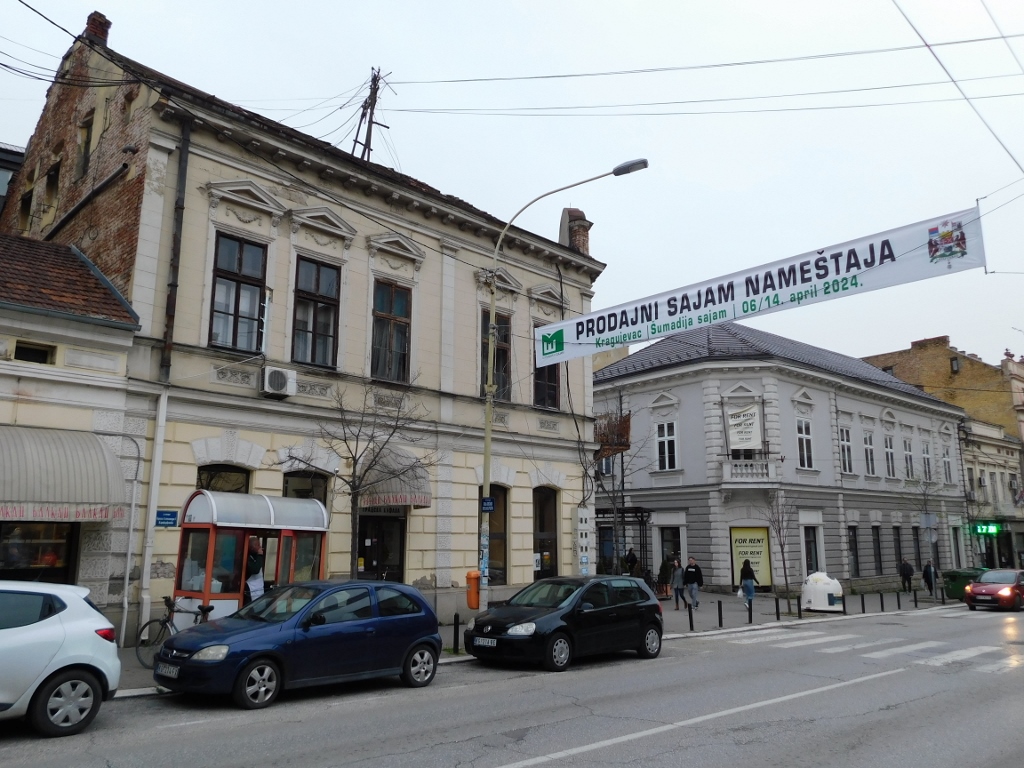 Kralja Aleksandra I Karađorđevića (street), a detail
Kralja Aleksandra I Karađorđevića (street), a detail
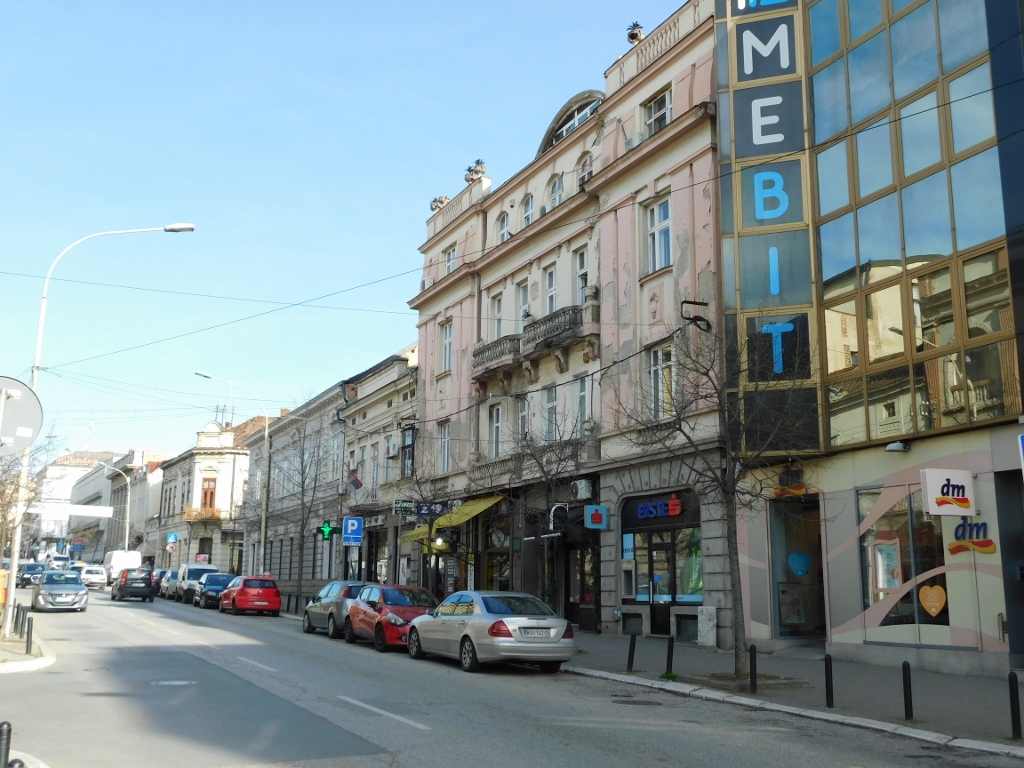 Kralja Aleksandra I Karađorđevića (street), a detail
Kralja Aleksandra I Karađorđevića (street), a detail
In this street, there is also a cultural monument that represents another immovable cultural property of great importance (!!!). It is listed in the documentation as the “Building at Maršala Tita (street) no. 121,” which is now Kralja Aleksandra I Karađorđevića (street). Regarding the exact number, it is uncertain; it could be either 19 or 21. Here is what this is about.
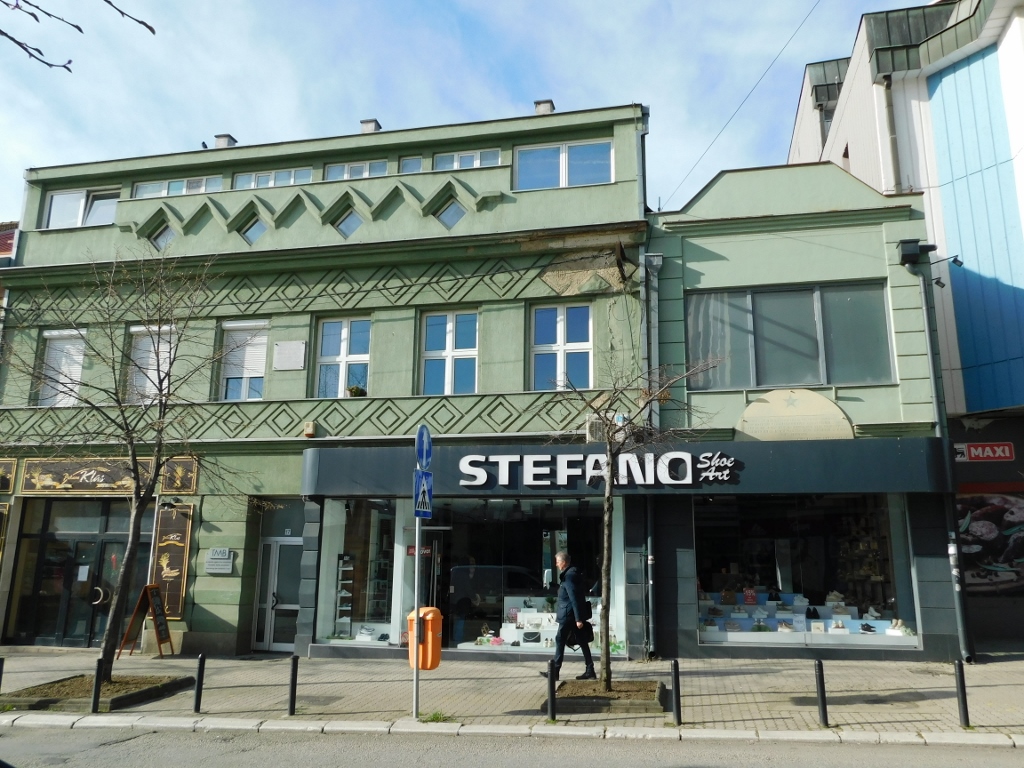 “Building at Maršala Tita no. 121” (this refers to the small house on the right-hand side)
“Building at Maršala Tita no. 121” (this refers to the small house on the right-hand side)
The house was built in the 19th century and although its architecture is not remarkable at all, its historical significance is considered substantial enough to declare it an immovable cultural property of great importance. The reason for this is that from 1873 to 1875, the Kragujevačka društvena štamparija (Kragujevac Social Printing Press) operated here. This is where Svetozar Marković (1846-1875), an influential Serbian socialist, publicist and political activist (one of the founders of the Socialist movement in Serbia), edited and printed two newspapers. He published a large number of economic and political articles in these newspapers.
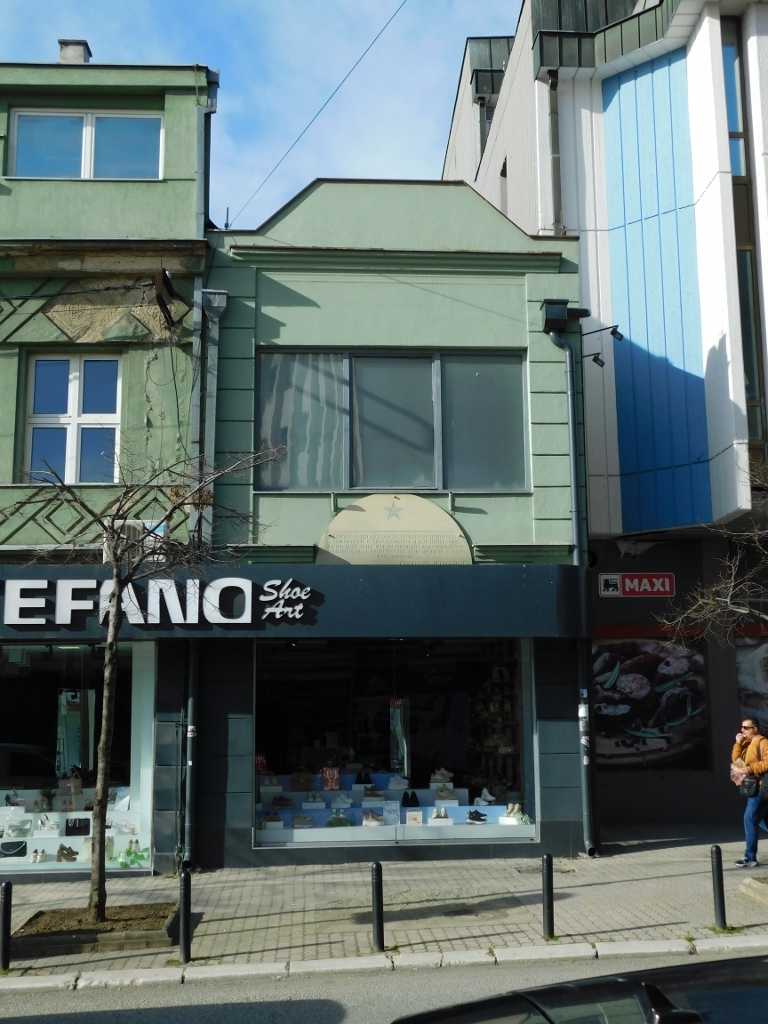 “Building at Maršala Tita no. 121”
“Building at Maršala Tita no. 121”
If you take a closer look at the previous photograph, you can see a semicircle with the following inscription: “From here, Svetozar Marković spread his revolutionary ideas through printed words. ‘Our main task is to disseminate the knowledge we possess as widely as possible and above all to ensure that we penetrate into the masses of the people.’”
I absolutely cannot escape the impression that the main criterion for declaring this house a cultural monument is precisely this “socialist and revolutionary” aspect of Svetozar Marković, who significantly advocated for “the masses of the people,” “revolution” and similar themes long before the Communist Party and World War II. This greatly qualified him in the eyes of the socialist authorities after WWII. (For decades, from 1946 to 1992, the city of Jagodina was even named Svetozarevo in his honour).
I am in no way diminishing the historical and social significance of Svetozar Marković. I simply wish to emphasise certain aspects which I believe were key criteria in determining the level of protection or categorisation of certain cultural properties. Moreover, in the meantime, this building has been connected via its ground-floor side wall to the adjacent building and now it is a unified space used as a shoe store. That’s it as far as the great significance of this cultural monument is concerned.
Regarding the numbering, the neighbouring house has the number 17 above its entrance, while the supermarket next door is numbered 23. Between them, there is only one smaller building with the address of the former Maršala Tita (street) no. 121.
The spatial cultural-historical complex in the centre of Kragujevac, representing a cultural monument of great importance, also includes Crvenog Barjaka (street) (or Crveno barjače, as written in the documentation) as one of the urban ensembles in the heart of the city.
This street was formed during the time of Prince Miloš and it got its name ("Red Banner") after the events at the beginning of 1876. Specifically, in the local elections in Kragujevac at the end of 1875, the radical-socialist option emerged victorious. However, the liberals decided to annul the elections and scheduled new ones for 27 February, 1876. Nevertheless, the socialists (followers of Svetozar Marković) won again in these elections. They celebrated by marching through the city, carrying a red flag sewn by two sisters (it’s interesting that this detail is known, including their names). This sequence of events, along with reports that slogans like “Long live the republic!” were shouted during the march, alarmed King Milan Obrenović (1854-1901). He feared a situation similar to the Paris Commune (1871) occurring in Serbia. The king sent troops, resulting in casualties, injuries and arrests.
In the past, this street had numerous houses with gardens. Today, it features both new and old buildings, all somehow expanding from a nearby farmers' market. There are many small shops and stalls on the sidewalk as well.
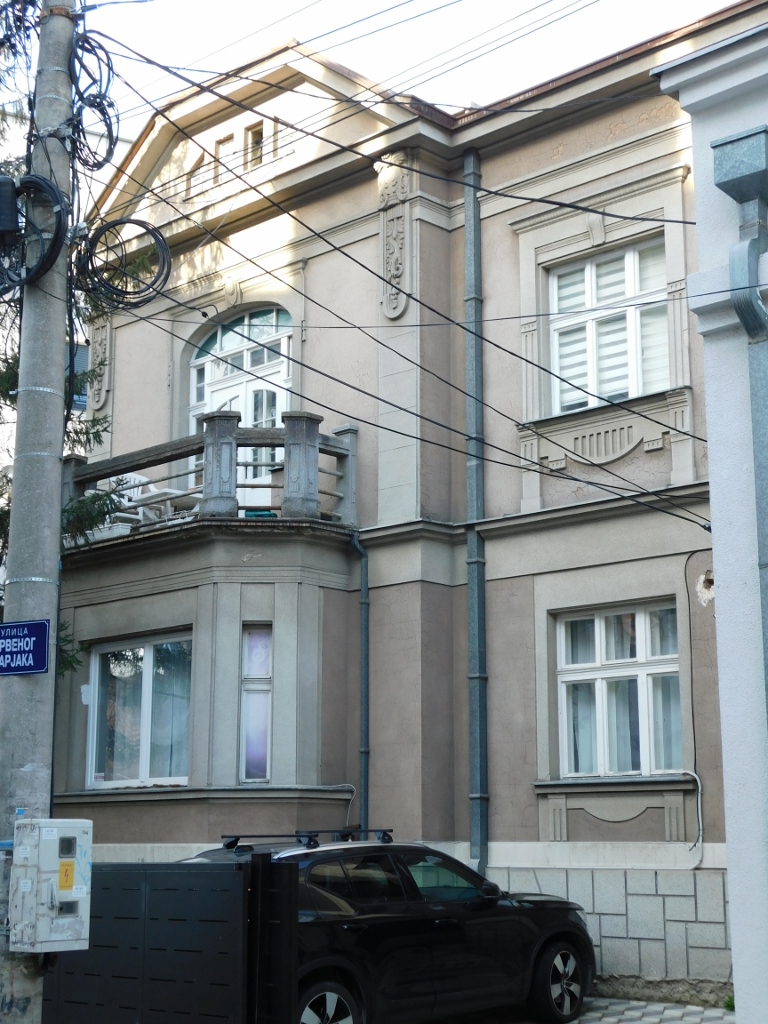 Crvenog barjaka (street), a detail
Crvenog barjaka (street), a detail
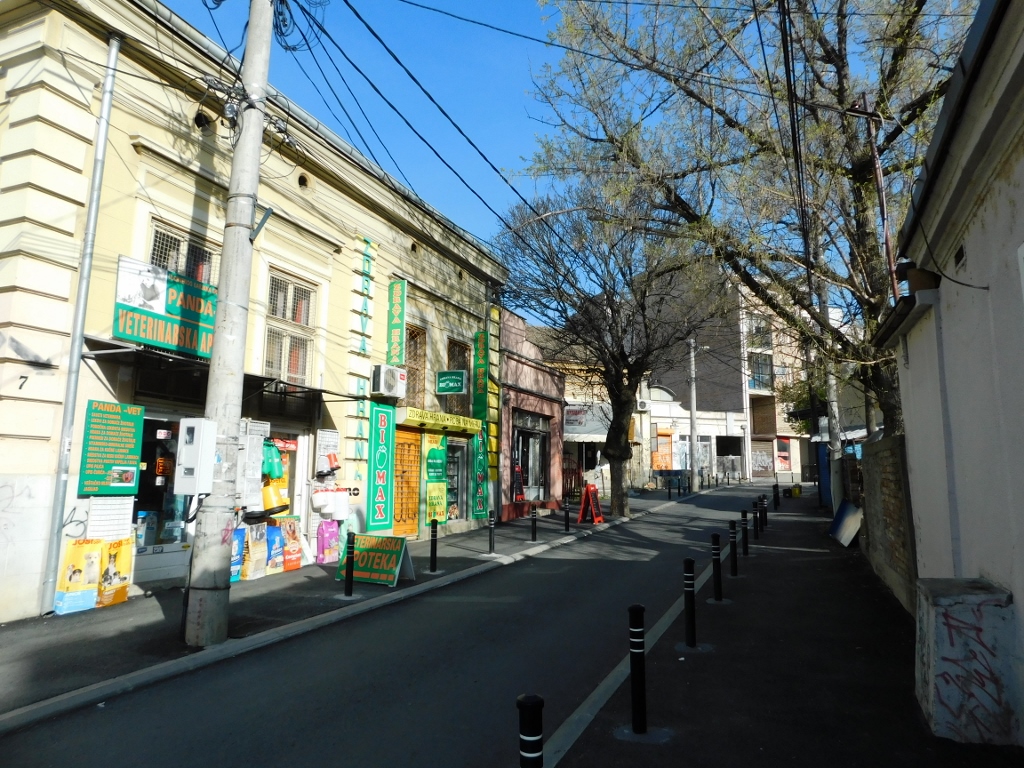 Crvenog barjaka (street), a detail
Crvenog barjaka (street), a detail
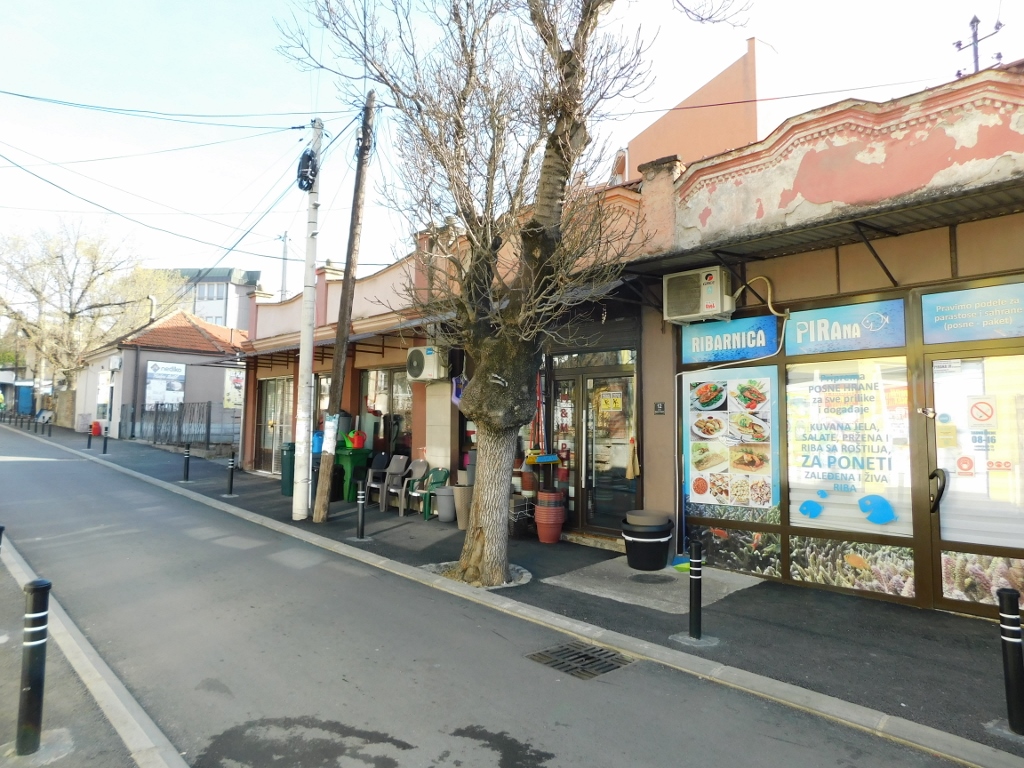 Crvenog barjaka (street), a detail
Crvenog barjaka (street), a detail
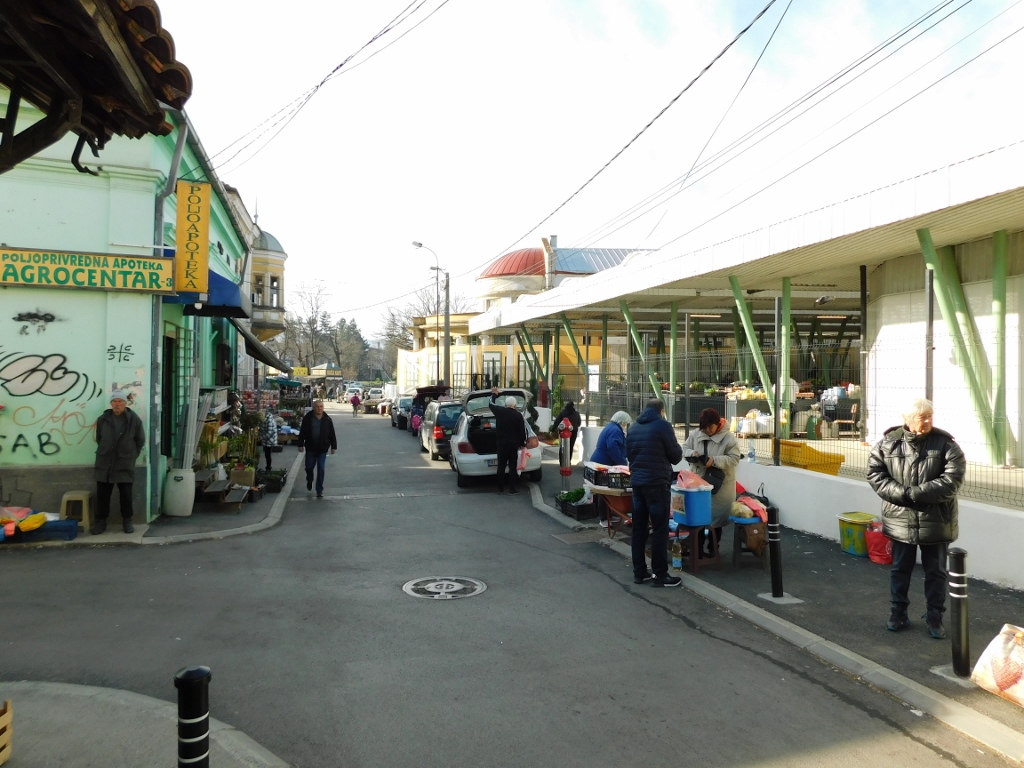 Crvenog barjaka (street), a detail
Crvenog barjaka (street), a detail
Across from the entrance to a newer market area, there is a building that appeared quite impressive to me.
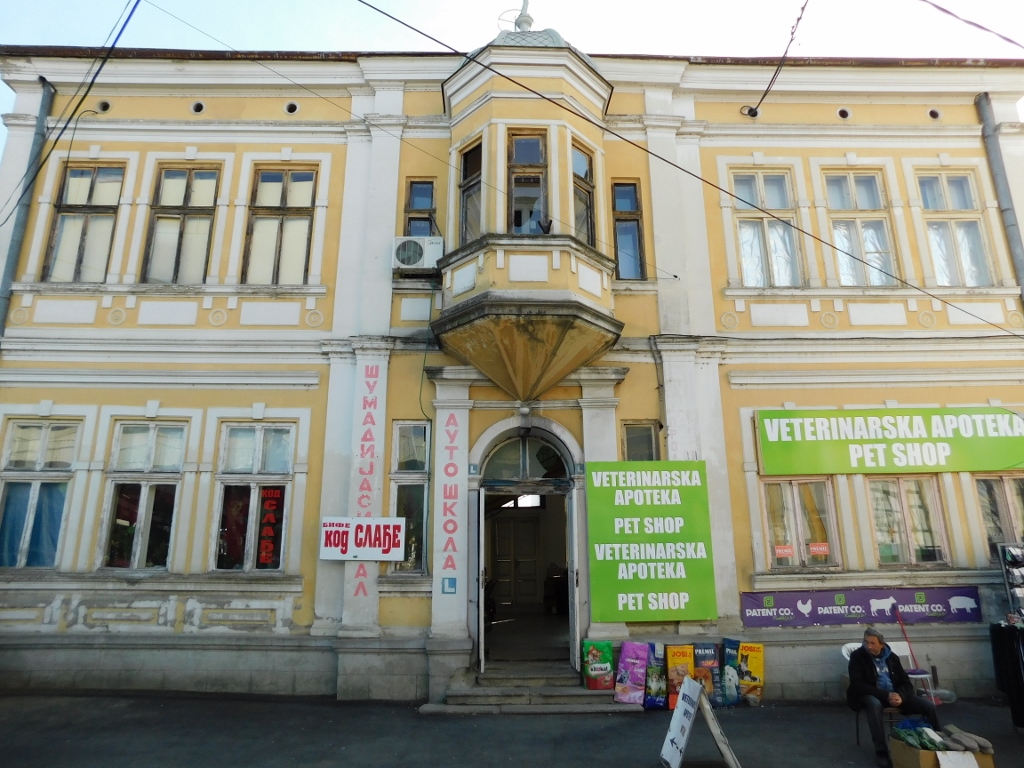 Crvenog barjaka (street), a detail
Crvenog barjaka (street), a detail
But what impressed me even more was when I saw the space of the main city farmers' market, the City Market, which is undergoing renovation.
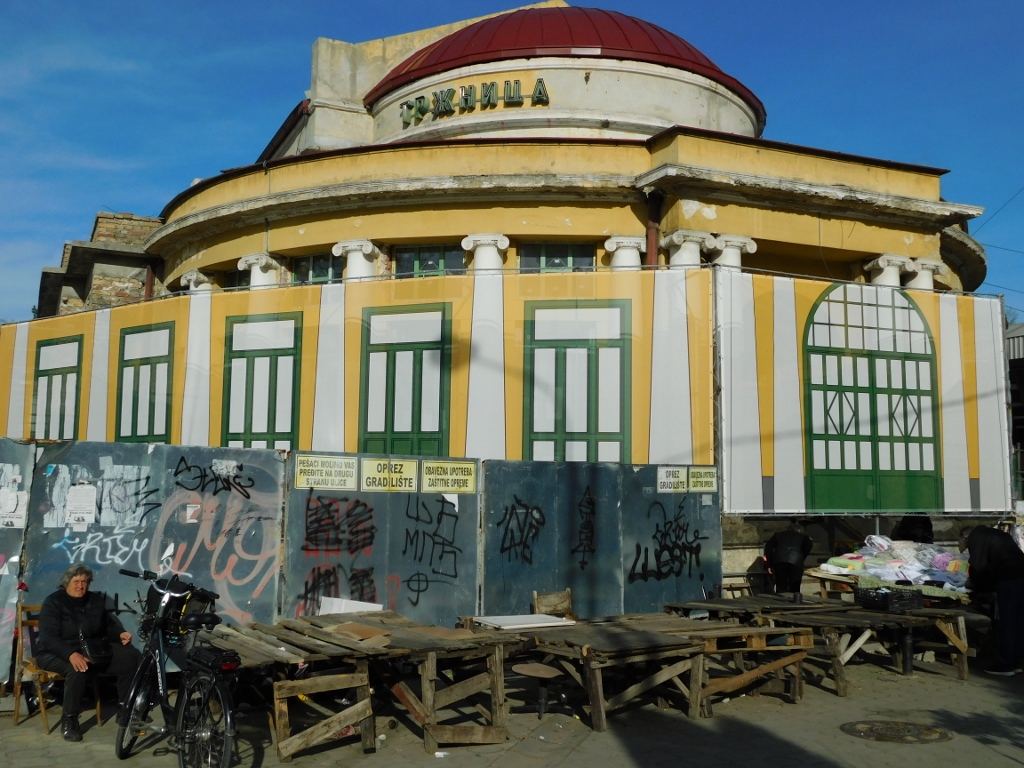 City Market during renovation
City Market during renovation
I was particularly pleased to see the renovation of the market building and the fence that showed what it should look when completed. However, I heard from locals in Kragujevac, with whom I had contact, that it had been like this for a few years now. Still, I hope that this building will be properly restored and returned to its function. To tell the truth, in March 2024, I didn’t see anyone working here and the entire construction site appeared closed and deserted.
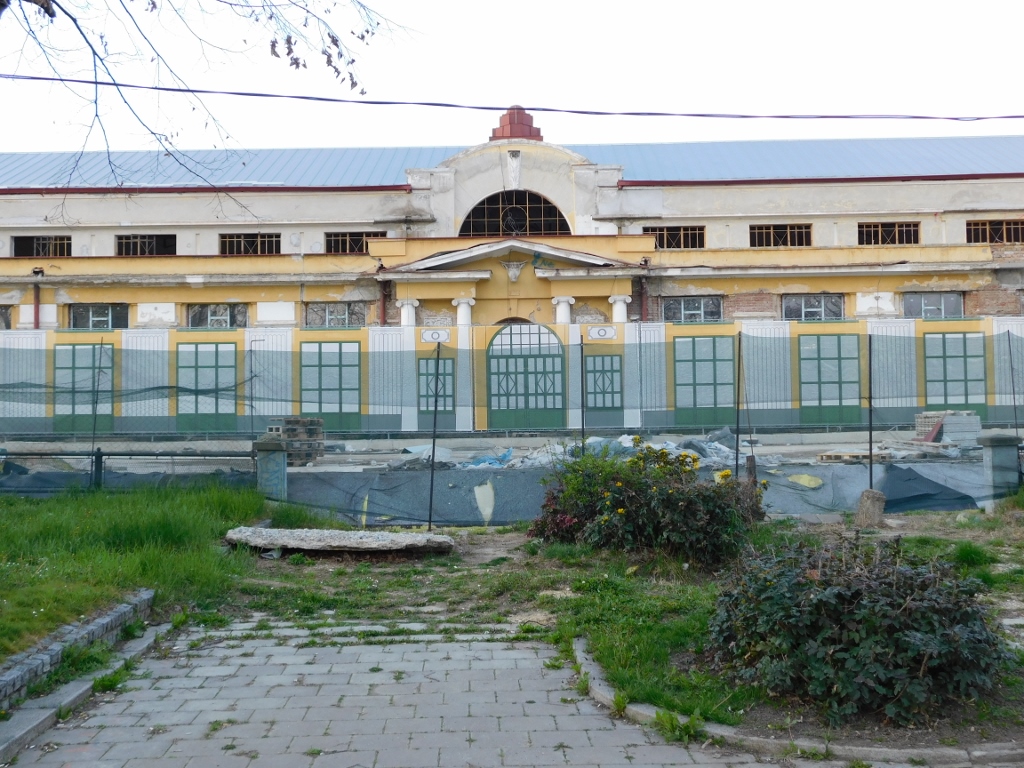 City Market during renovation
City Market during renovation
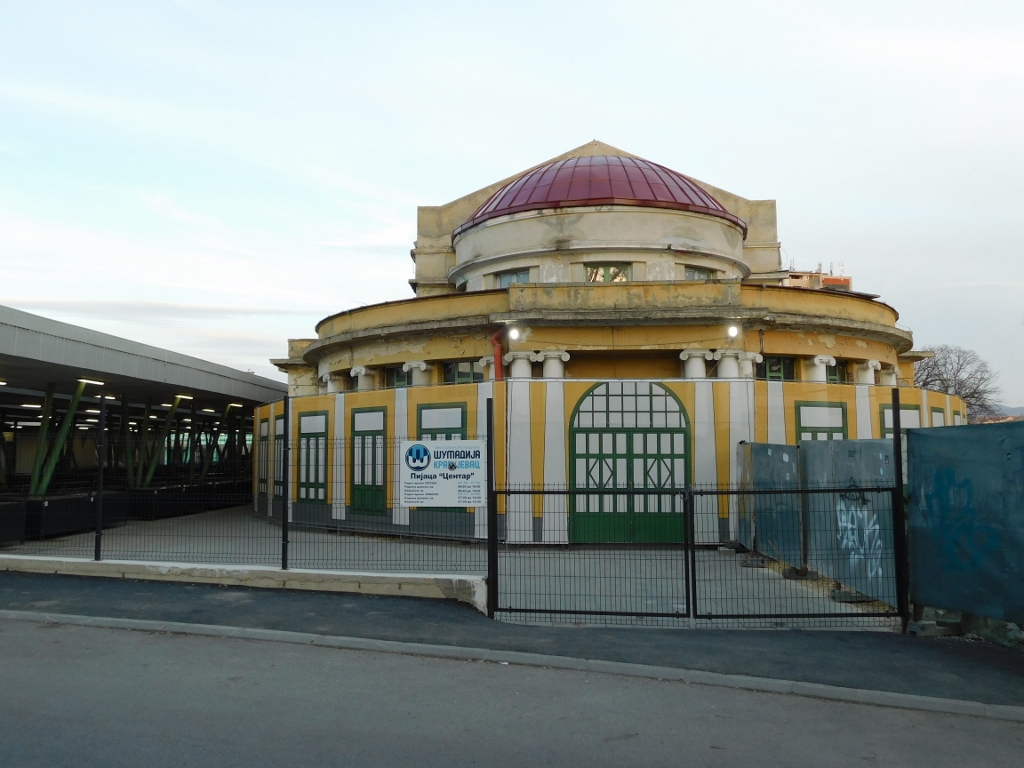 City Market during renovation
City Market during renovation
The City Market is located next to Mali Park (Small Park), where there is a cultural monument, but I’ll talk about it later on. Right now, I want to focus on the spatial cultural-historical ensemble in the centre of Kragujevac.
At the end of Crvenog Barjaka (street), between some kind of cages that seem to serve as storage space, I also noticed a passage leading to another old house. It reminded me of the few houses in Svetozara Markovića (street) that are designated as cultural monuments.
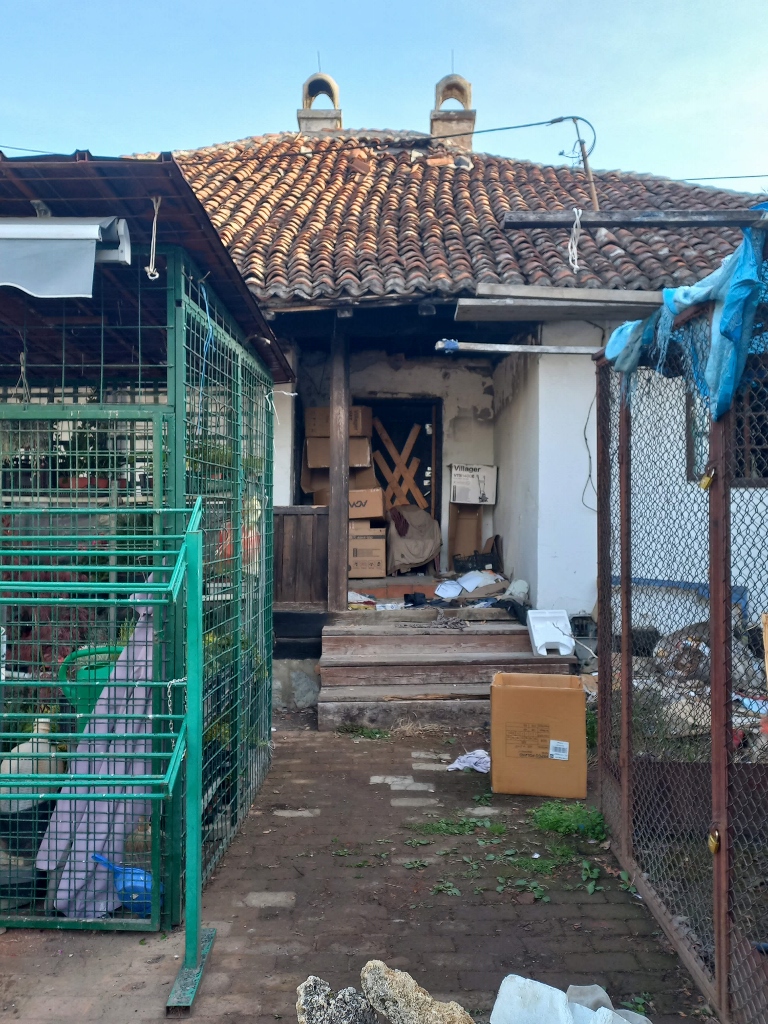 Neglected old house at the end of Crvenog barjaka (street)
Neglected old house at the end of Crvenog barjaka (street)
This house wasn’t on my list of national cultural monuments, although to me, judging by its roof and chimney, it seemed like it could also be from the 19th century. I don’t know the criteria used to declare something a cultural monument, while ignoring something else. It’s a dilemma that often comes to my mind when I see certain buildings, either because I think they deserve such recognition and don’t have it, or vice versa. This house is clearly in poor condition, at least its entrance, and it’s almost certain that it is waiting for an investor to demolish it and use the land.
However, not all the beautiful houses and buildings in this part of the city are neglected. In fact, it is quite clear that some of them have started to have their facades renovated. For example, in 27. marta (street) that is also a significant urban ensemble within the immovable cultural property of great importance that I’m discussing now.
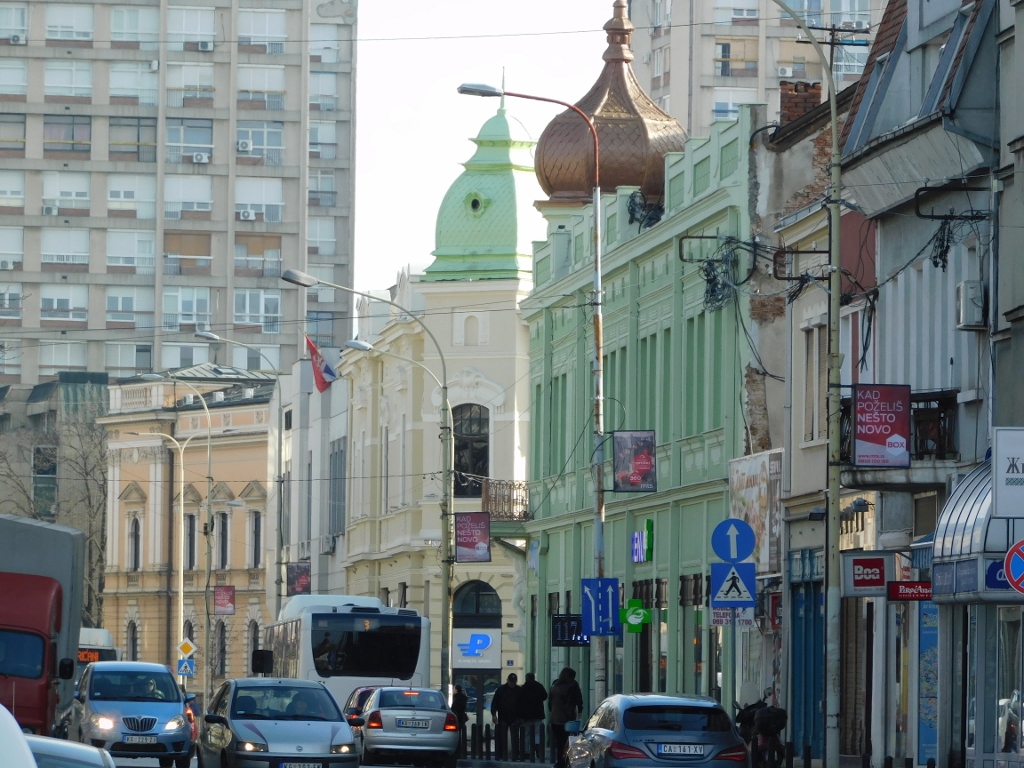 27. marta (street), a detail
27. marta (street), a detail
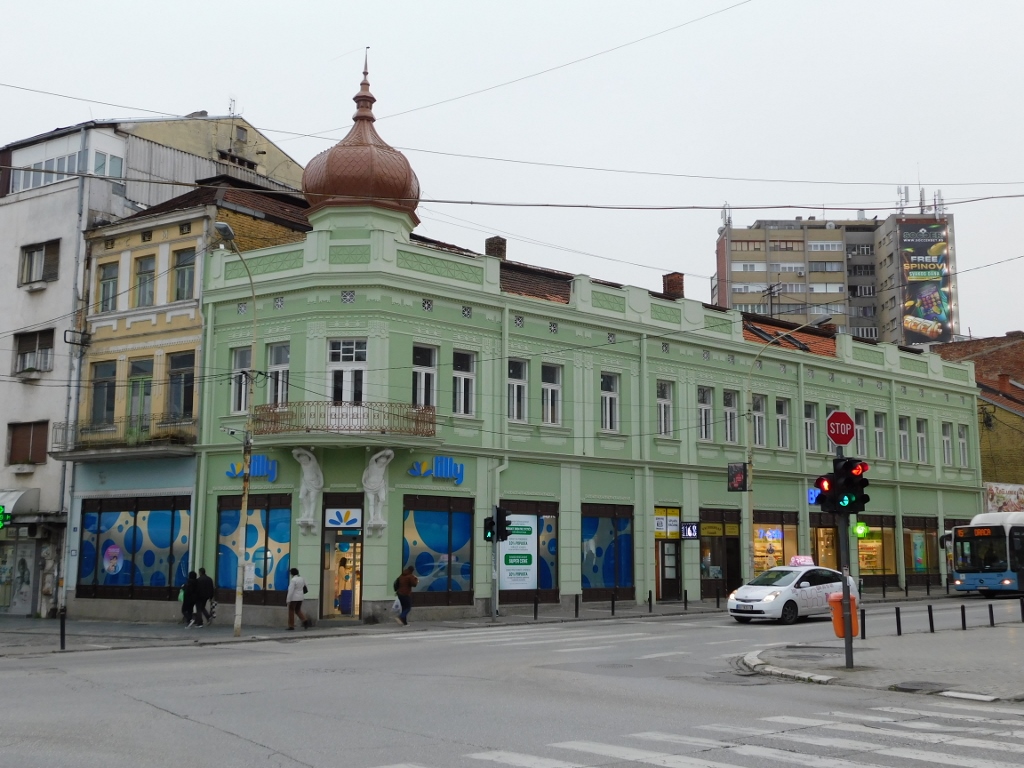 27. marta (street), a detail
27. marta (street), a detail
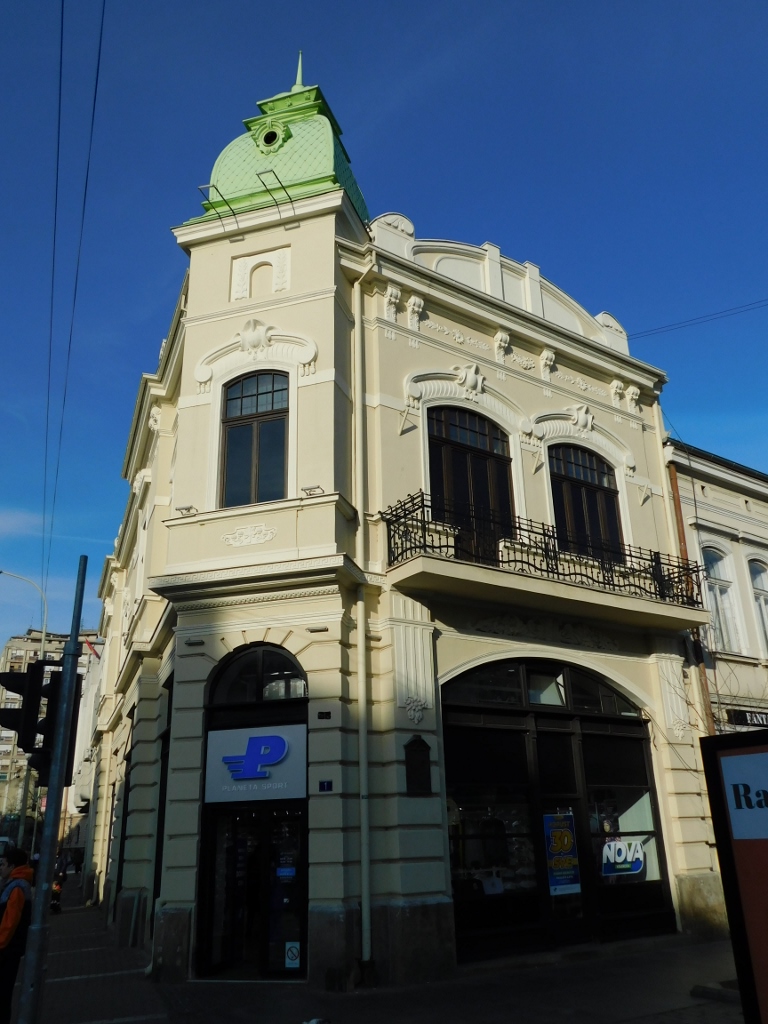 27. marta (street), a detail
27. marta (street), a detail
As seen in the previous photos, some of the buildings here have been beautifully restored, at least their facades, but there are also some that are still waiting, like a building from 1931 on the opposite side of the street.
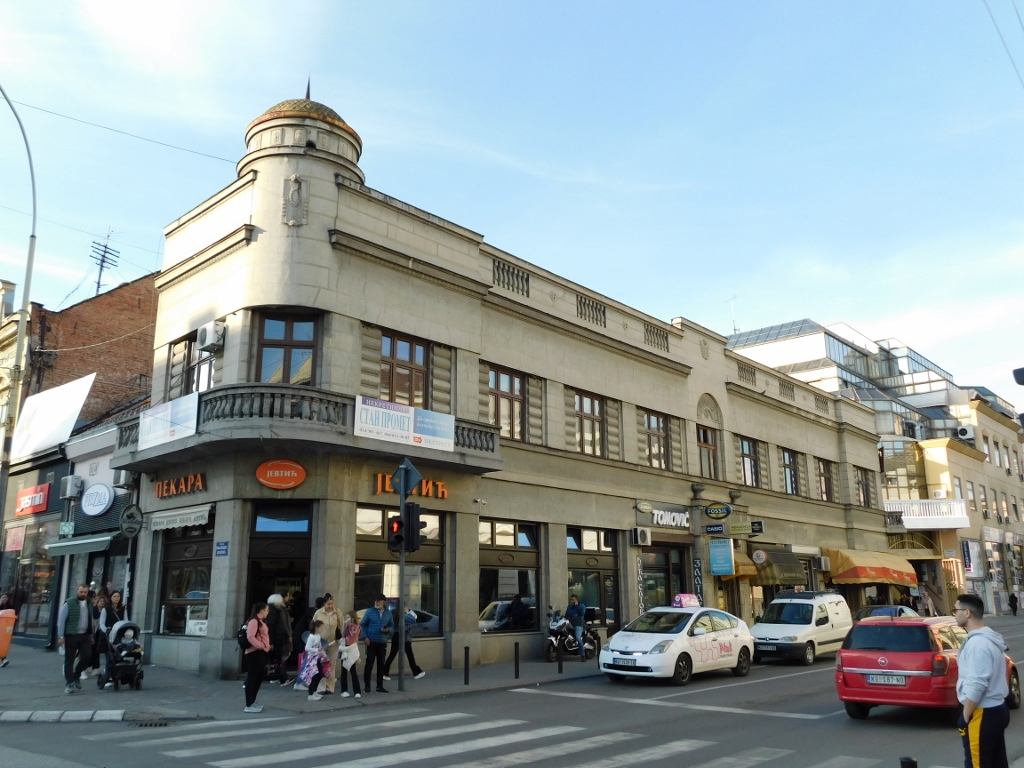 27. marta (street), a detail
27. marta (street), a detail
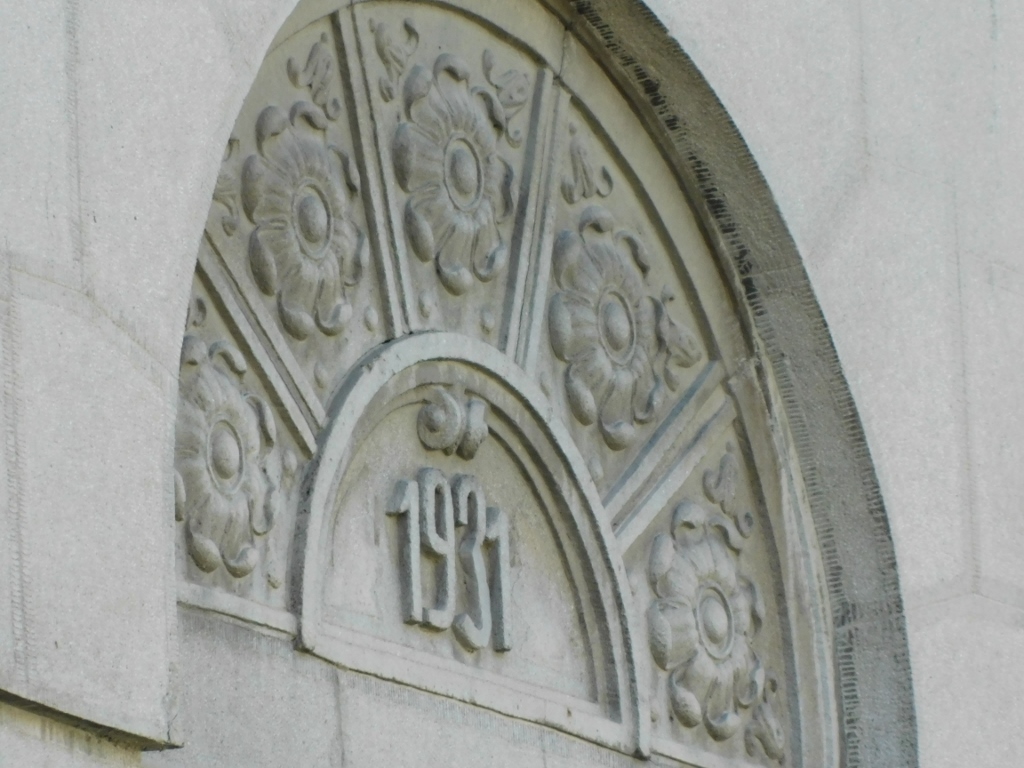 27. marta (street), a detail
27. marta (street), a detail
Kralja Petra I (street), which intersects with 27. marta and continues from Kralja Aleksandra I Karađorđevića, also falls within the area designated for the protection of the 1st degree. There, I captured a building with a beautifully restored facade that actually occupies an entire block.
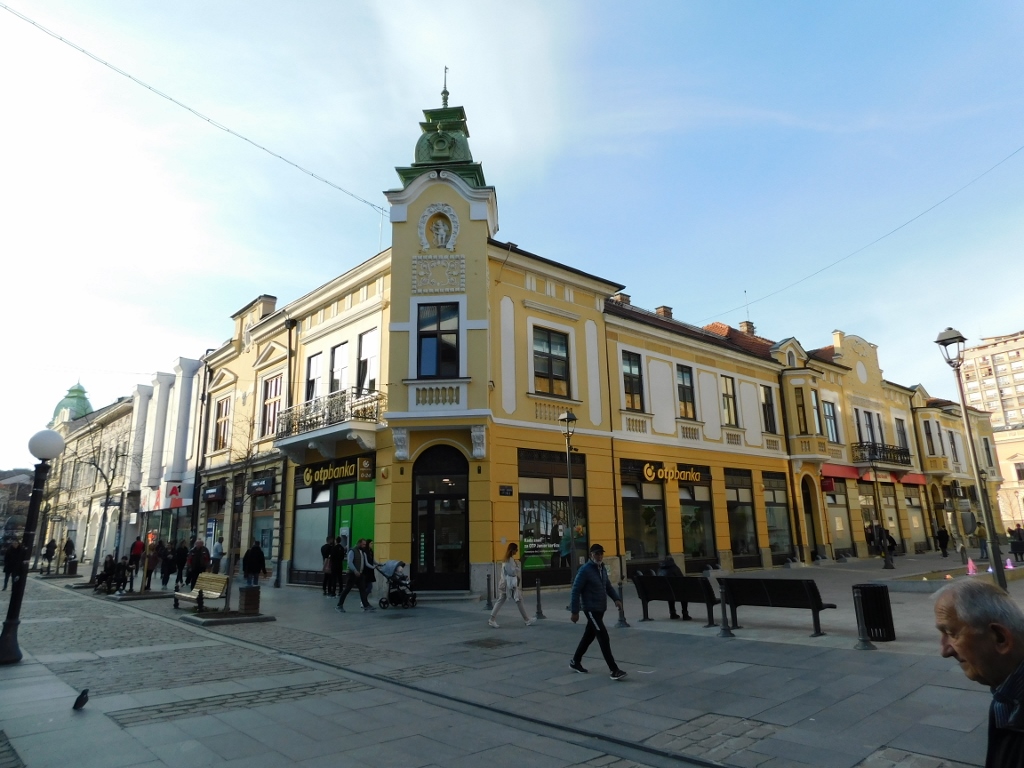 Kralja Petra I (street), a detail
Kralja Petra I (street), a detail
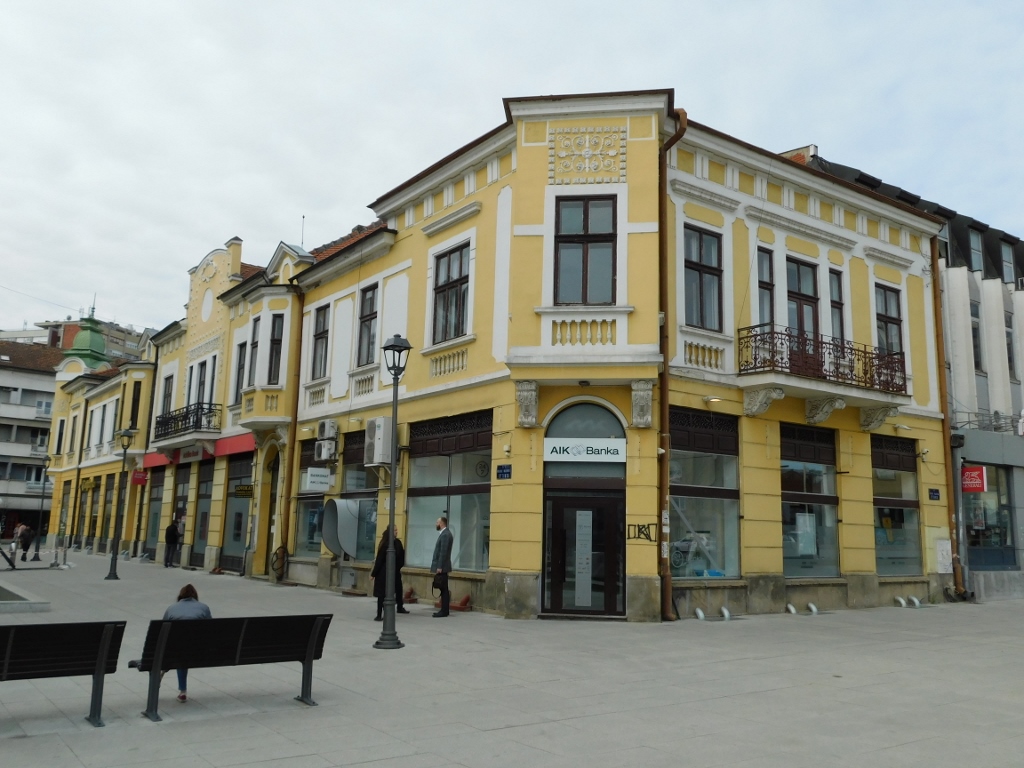 Kralja Petra I (street), a detail
Kralja Petra I (street), a detail
One end of this building faces Trg Radomira Putnika (Radomir Putnik Square), where, among other things, the Palace of Culture in Kragujevac is located. I’ll share more about this renowned building a bit later.
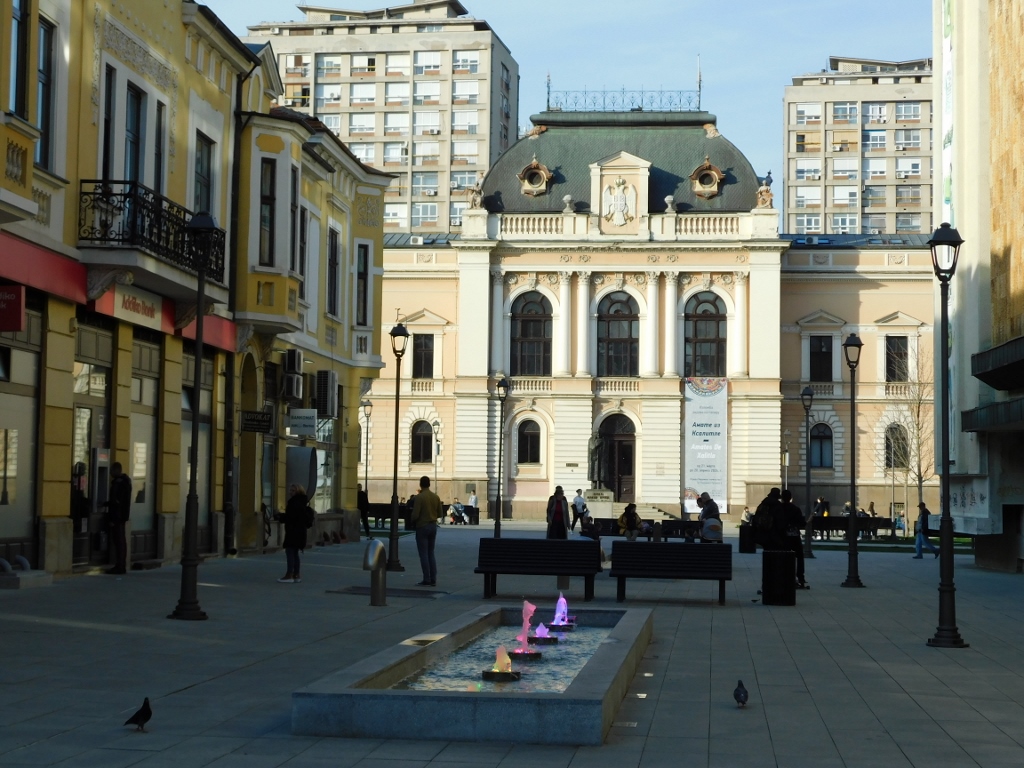 Kralja Petra I (street) and the Palace of Culture in Kragujevac
Kralja Petra I (street) and the Palace of Culture in Kragujevac
I walked along Kralja Petra I (street) and passed by the Trg narodnih heroja (National Heroes Square), also known as Trg Kod krsta (At the Cross Square). Gradually, as Serbia liberated itself from the Ottoman Empire, from 1830 fairs and free trade were allowed and thus a market was organised at this location. As this became a regular gathering place, a wooden cross was erected here, symbolising the transition from the Islamic Ottoman Empire to the Christian Serbia. It is important to note that during this time, Kragujevac was the capital of Serbia (1818-1841). When the communists came to power after World War II, the cross was removed in 1946.
However, this elongated oval-shaped square, as a prominent space in the city centre, was also used during World War II as a place where members of the youth communist organisation (SKOJ) and partisans captured in the city and its surroundings were hanged in order to instil fear in the population. I don’t think it succeeded. In any case, this place also served as a mass grave where Serbian fighters killed in the Kragujevac area were buried. It is believed there are 62 of them.
After WWII, the first memorial was erected here and over time the square gained its official name of the National Heroes Square, which is still in use today.
During the 1990s, near the memorial ossuary, a fountain in the form of a stone flower was installed in the square, while the cross was also returned, along with the colloquial name for the square – Kod krsta (At the Cross). Unfortunately, although I passed here several times, I didn’t take a photo of the cross, but I have a few details from the square itself.
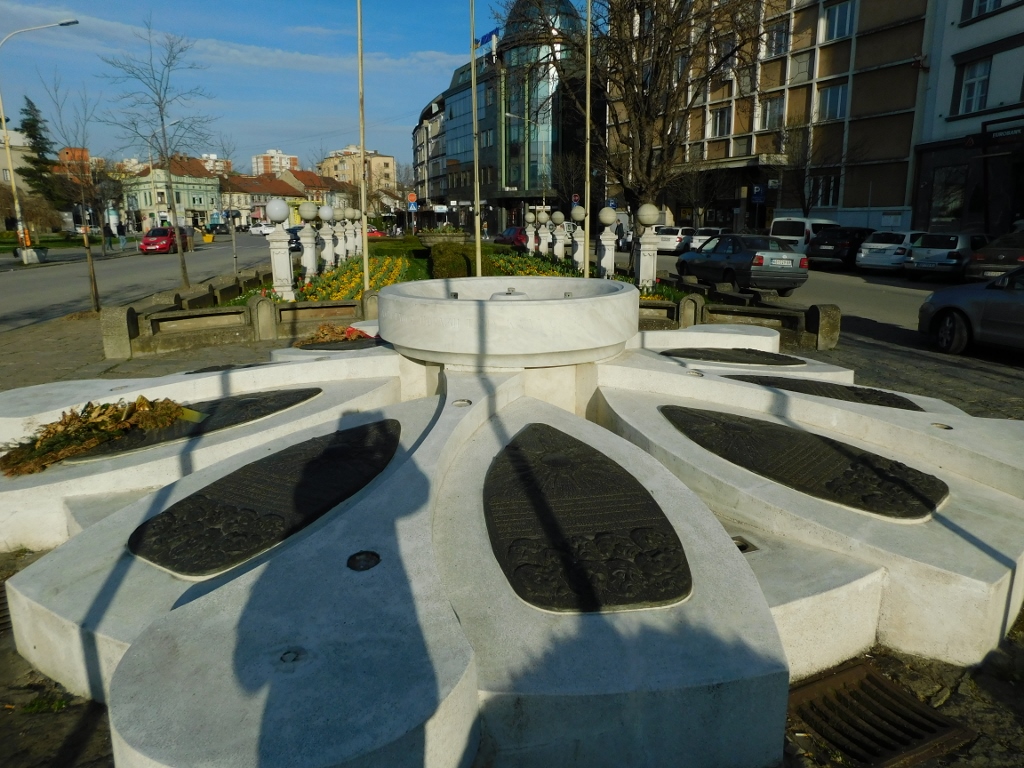 National Heroes Square, a detail
National Heroes Square, a detail
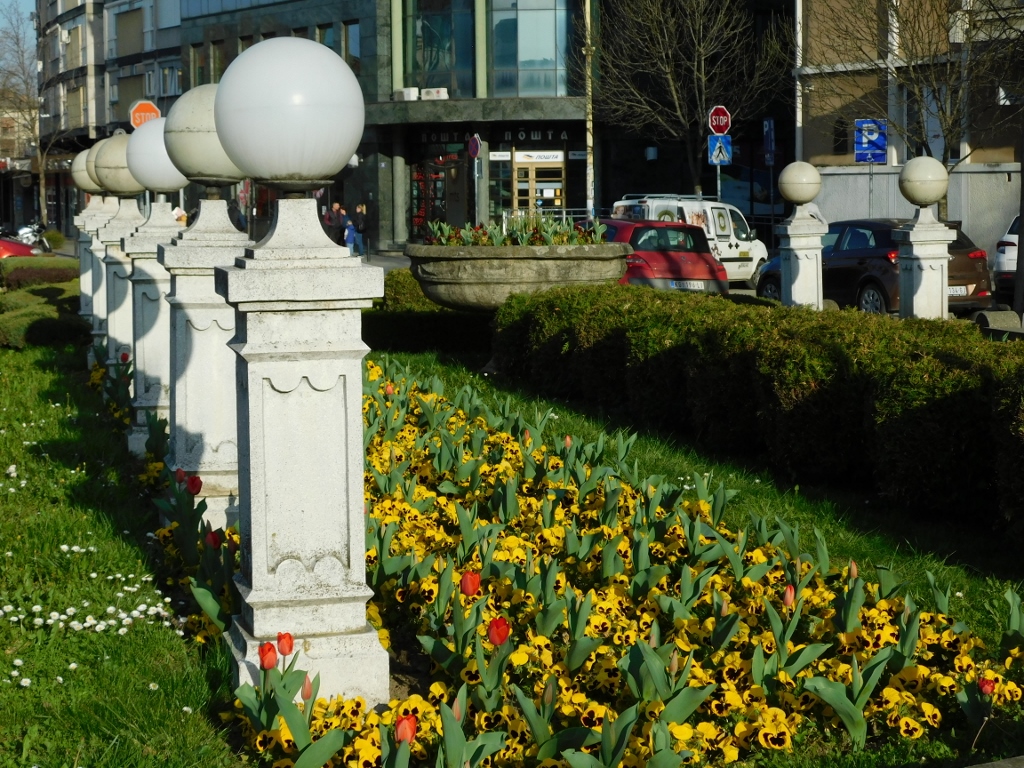 National Heroes Square, a detail
National Heroes Square, a detail
Lole Ribara (street) is also a part of the spatial cultural-historical ensemble of great importance according to the official categorisation, named “Urban Ensembles, M. Tita, Lole Ribara, 27. marta and Crveno Barjače streets”. Historically, this street mainly housed artisan workshops and shops. Today, a similar situation persists, but the appearance of the houses and these “artisan workshops and shops” seemed quite chaotic to me.
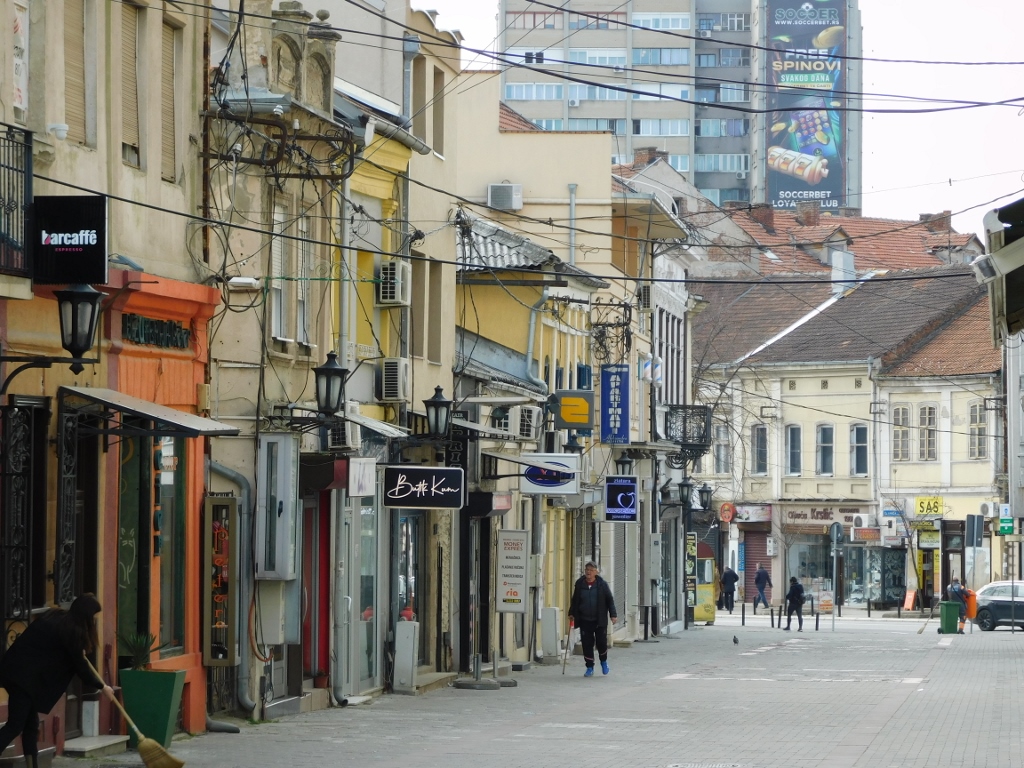 Lole Ribara (street), a detail
Lole Ribara (street), a detail
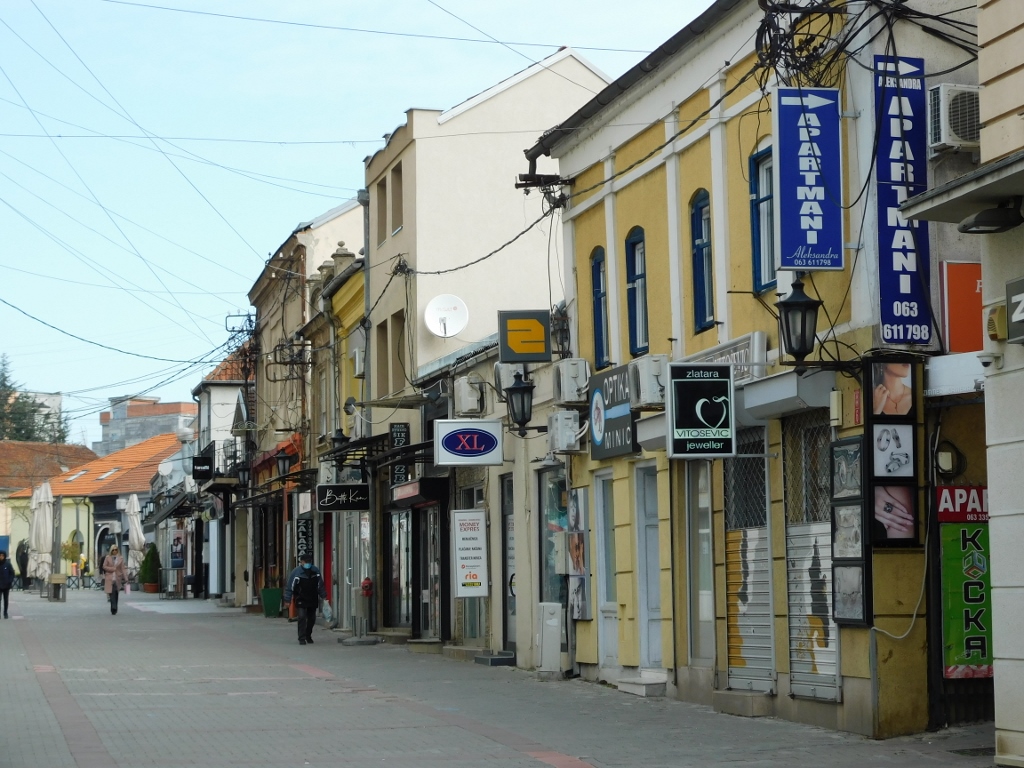 Lole Ribara (street), a detail
Lole Ribara (street), a detail
At the end of Lole Ribara (street) stands the Hotel “Zelengora,” which is one of the endowments of Milovan Gušić (1822-1891), a merchant and senior infantry captain. In the next photograph, you can see the dome that is a part of the hotel.
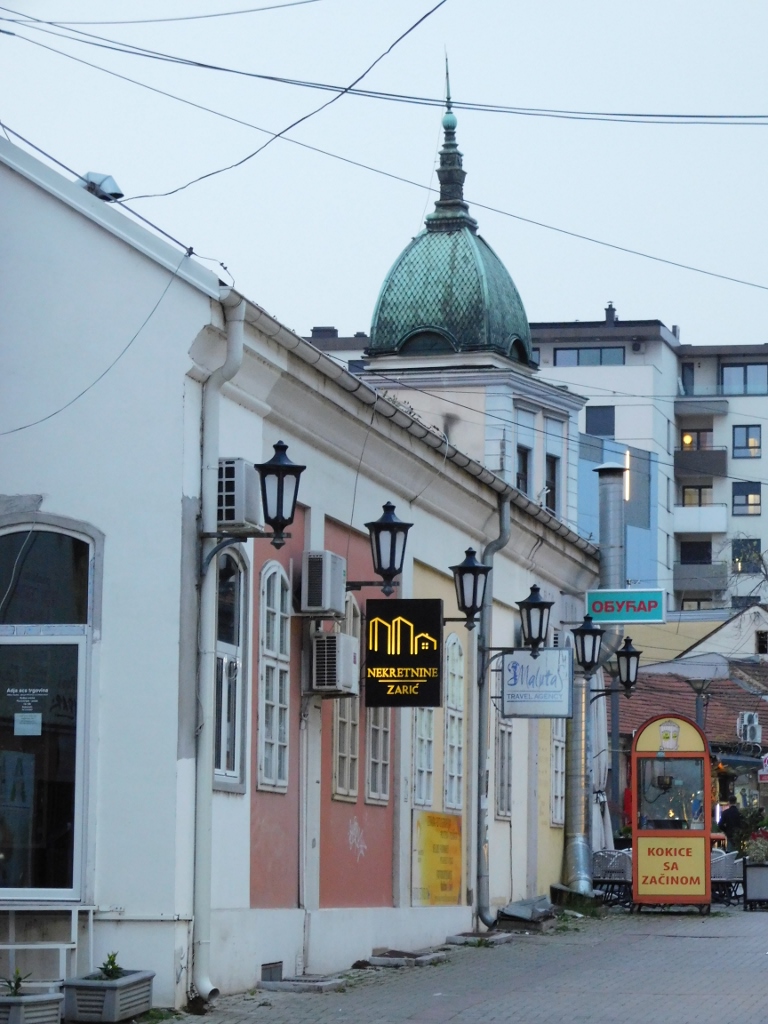 Lole Ribara (street), a detail
Lole Ribara (street), a detail
When you leave the Hotel “Zelengora” and head towards 27. marta (street) via Miloja Pavlovića (street), you pass by another cultural monument, the Fire Station in Kragujevac, a large building located at the corner of streets in the heart of the city. One of its distinctive features is the five-storey tower. Interestingly, I have read that the building was designed by leading architects in Serbia at that time and that it is a “representative example of eclecticism” in Kragujevac.
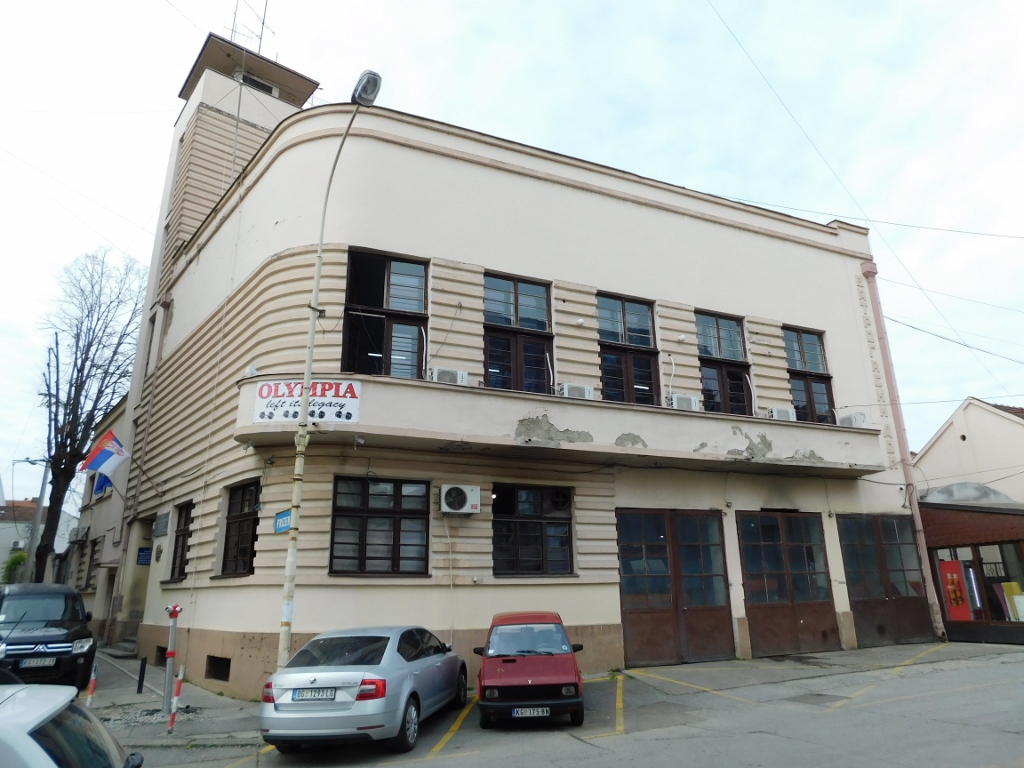 Fire Station in Kragujevac
Fire Station in Kragujevac
The building was erected between 1933 and 1936 as an endowment of Jelena N. Radojkić and her gift to the people of Kragujevac is still honoured today. In the next photo, you can see a plaque with her name and also a national flag.
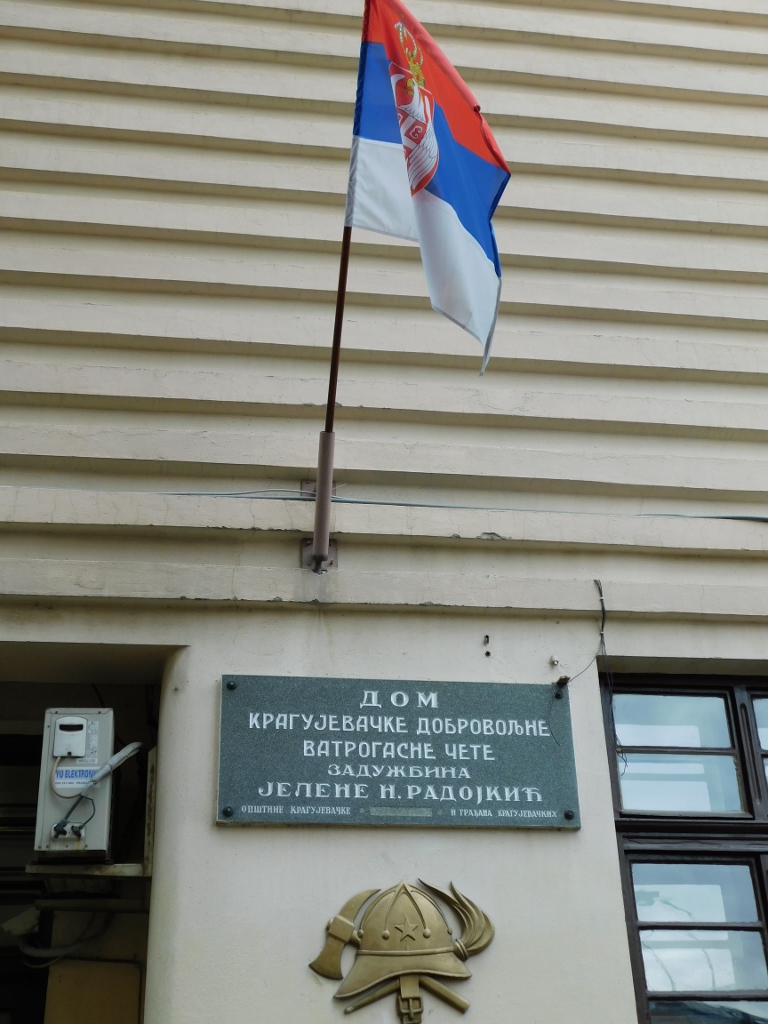 Fire Station in Kragujevac, a detail
Fire Station in Kragujevac, a detail
The building continues to serve the needs of fire-fighters, but there is also a gym located on one of its floors. During my visit here, the fire trucks were neatly parked and there was no immediate need for them.
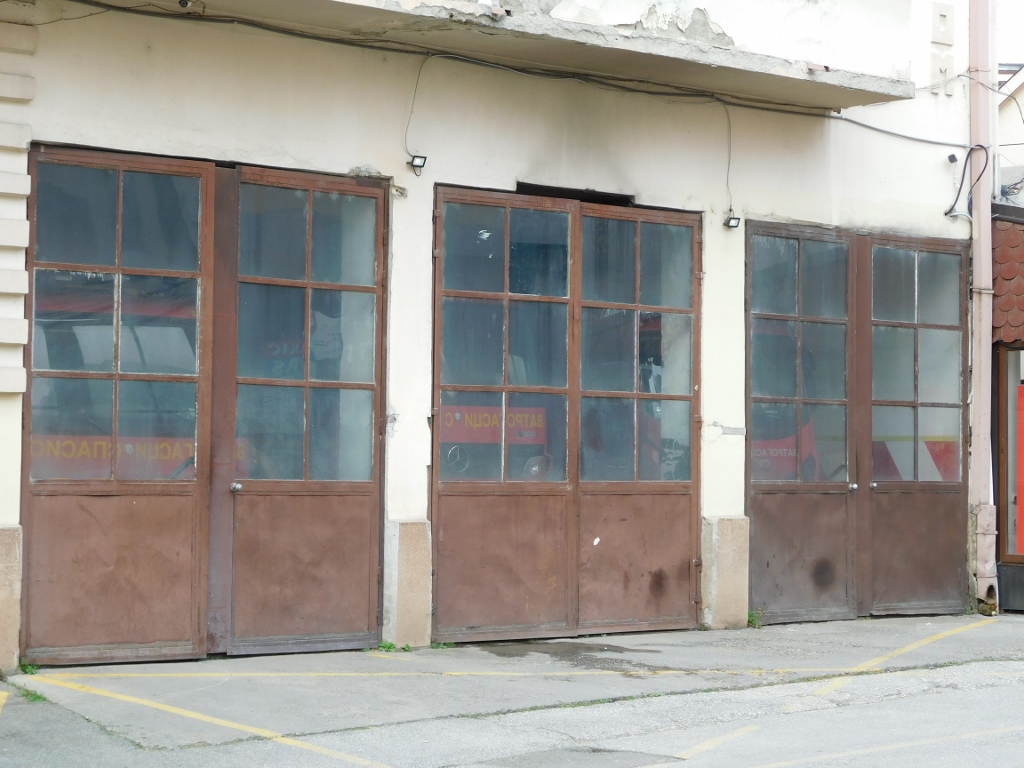 Fire Station in Kragujevac, a detail
Fire Station in Kragujevac, a detail
A few dozen metres further, on the other side of the street and now at the corner with 27. marta (street), there is another cultural monument, the large “Ured” Building, built in 1931.
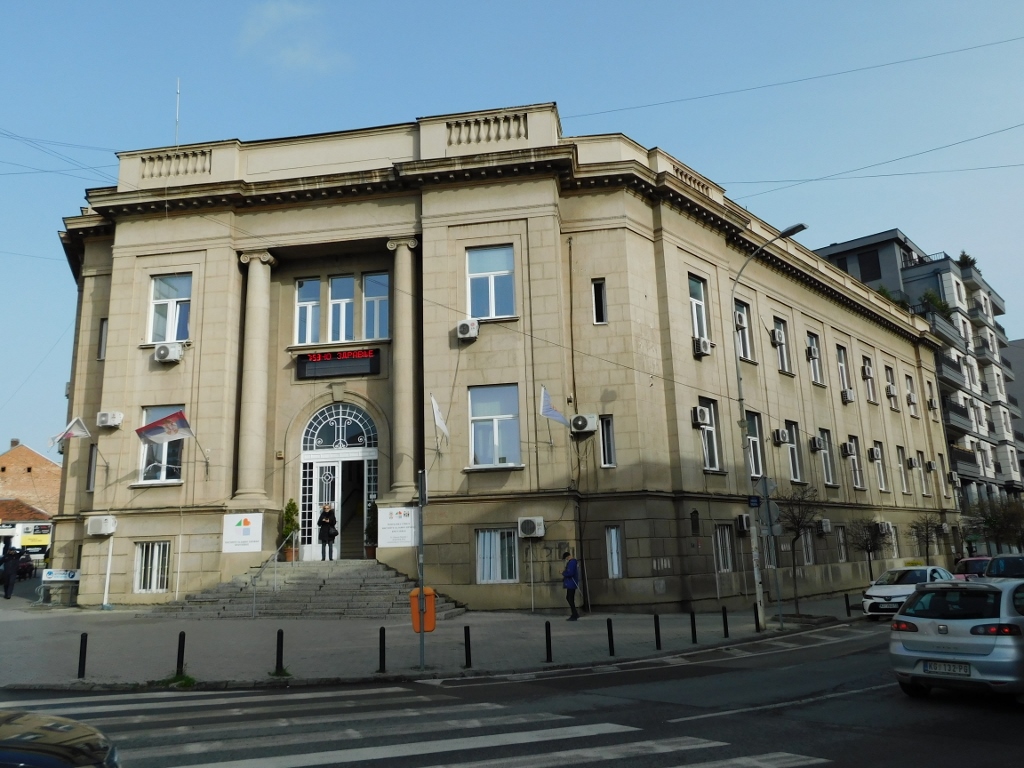 “Ured” Building in Kragujevac
“Ured” Building in Kragujevac
The building was constructed for the needs of the workers’ health insurance office, but it holds architectural significance because it was designed by Professor Bogdan Nestorović (1901-1975) from the Faculty of Architecture in Belgrade. In addition to administrative offices, the building housed clinics and various medical departments, including steam baths with tubs for physical therapy. Today, the building is home to the Public Health Institute in Kragujevac.
After crossing 27. marta (street) here, you reach Trg Radomira Putnika (Radomir Putnik Square) where, among other things, the Palace of Culture in Kragujevac is located.
 “Ured” Building (left) and the Palace of Culture in Kragujevac (right)
“Ured” Building (left) and the Palace of Culture in Kragujevac (right)
The building is listed in the documentation on the cultural monuments as the Zgrada Okružnog suda (District Court Building), as it used to house courtrooms until recently, although it was originally built for the needs of the District Prefecture.
In any case, the building designated as an immovable cultural property of exceptional importance was constructed between 1902 and 1904.
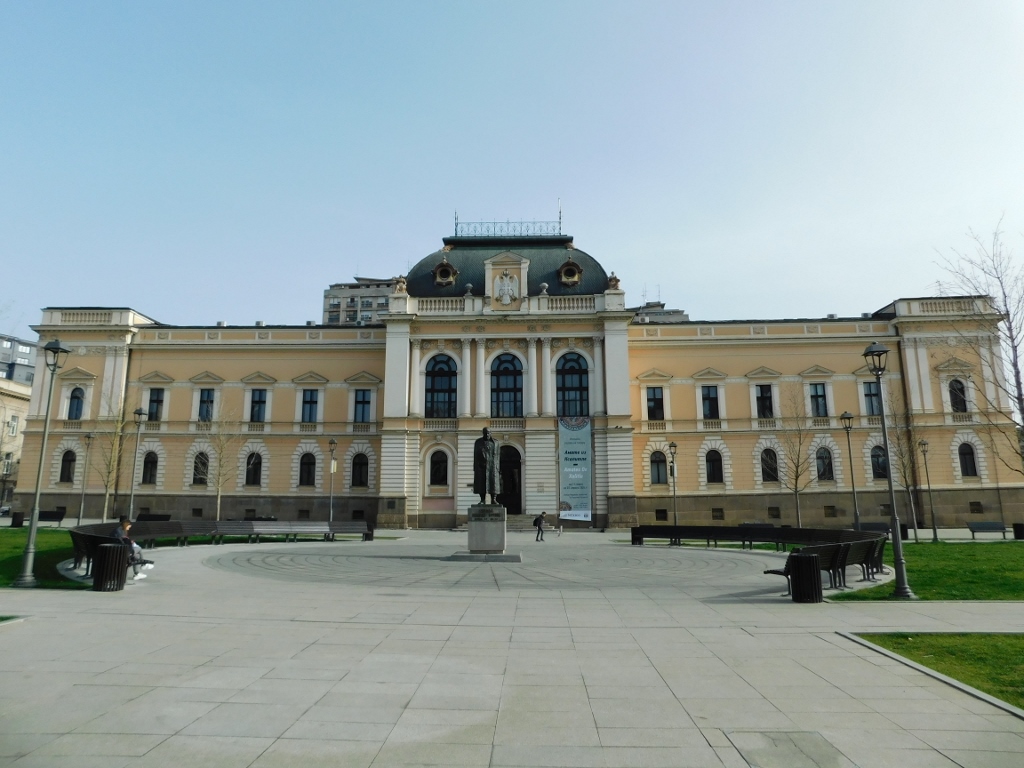 Palace of Culture in Kragujevac
Palace of Culture in Kragujevac
The building was erected as a representative structure because at the beginning of the 20th century there was not only a need for such buildings, but also a desire for Serbia to catch up with more developed European countries by constructing grand state buildings. Its architect, Nikola Nestorović (1868-1957), who incidentally was the father of Bogdan Nestorović mentioned earlier, studied architecture in Berlin.
The facade prominently features a central avant-corps, adorned with a variety of decorative elements. Above the avant-corps, there is a four-sided dome with a flattened top and, on either side at the top of the avant-corps, there are sculptures of female figures representing “Justice” and “Law.”
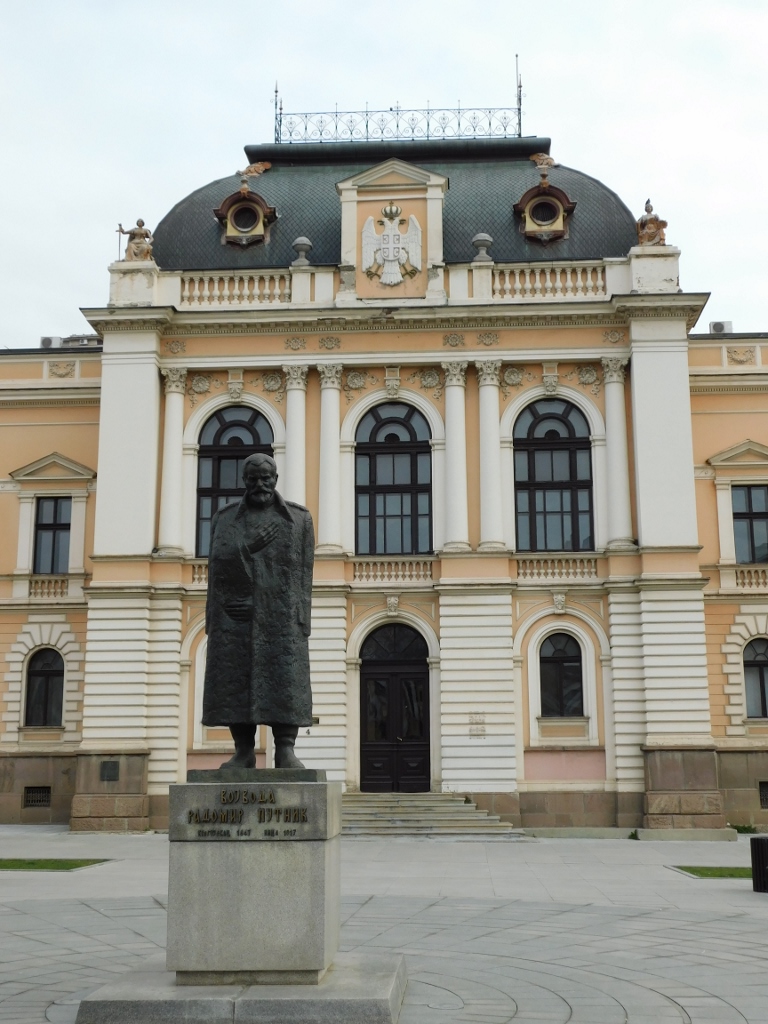 Palace of Culture in Kragujevac, a detail
Palace of Culture in Kragujevac, a detail
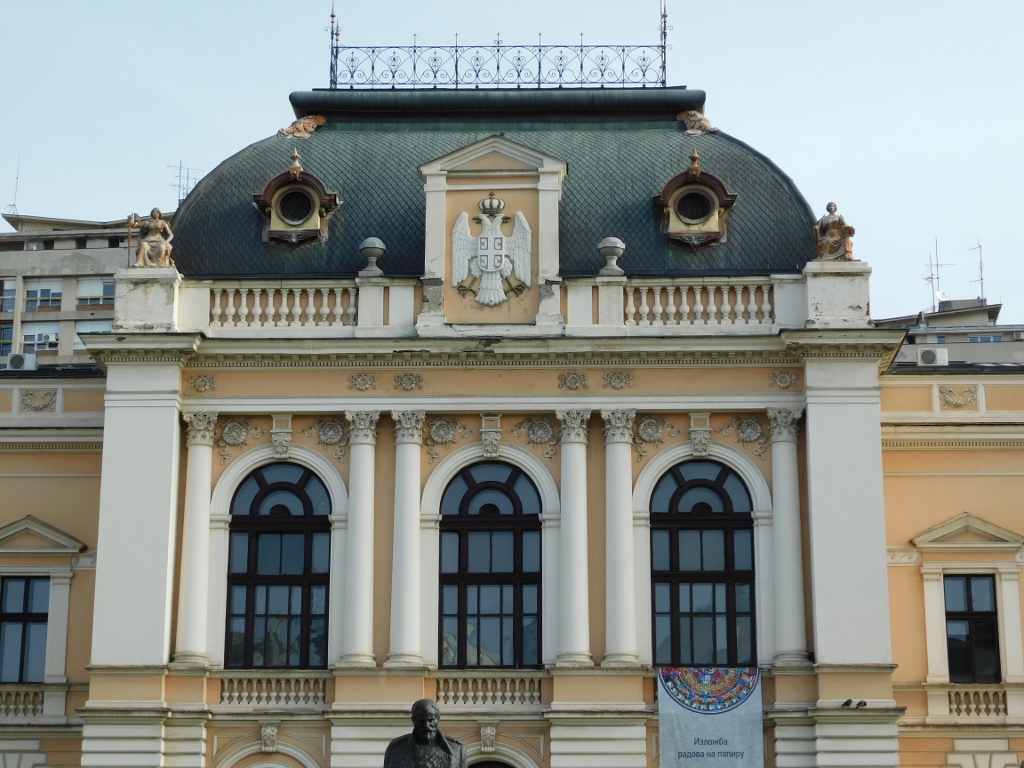 Palace of Culture in Kragujevac, a detail
Palace of Culture in Kragujevac, a detail
During World War One, from 26 July, 1914 to 23 October 1915, this building housed the Serbian High Command. Today, in front of it, there is a monument to Radomir Putnik, after whom the entire square was named.
Namely, Radomir Putnik (1847-1917) was the Chief of the General Staff of the Serbian Army during the Balkan Wars (1912-1913) and WWI. He was the main strategist of the Serbian army in these military conflicts and due to his great success in the Battle of Kumanovo in 1912, he was promoted to the rank of vojvoda, equivalent to a field marshal.
This also brings me to the change in the building’s name, from the District Court Building to the Palace of Culture. After the judiciary moved to the purpose-built Palace of Justice, this large building in the centre of Kragujevac remained vacant. Discussions, plans and proposals regarding its new use then began. Most ideas revolved around utilising the interior space for a library, archives and the local institute for the protection of cultural monuments. I’ve also read about proposals to establish a museum here dedicated to the WWI and Serbia’s participation therein. To me, this would make absolute sense, but I’m not sure how far these plans have progressed.
In any case, it’s clear that most plans focus on cultural uses for the building, hence the new name – the Palace of Culture.
From what I could find online, until recently, the building was in quite poor condition, with parts of the facade crumbling. That has since changed, with the exterior now beautifully restored and the square itself has gained some modern elements, such as a nearby fountain. Additionally, the building is illuminated at night, highlighting its beauty during evening and night hours.
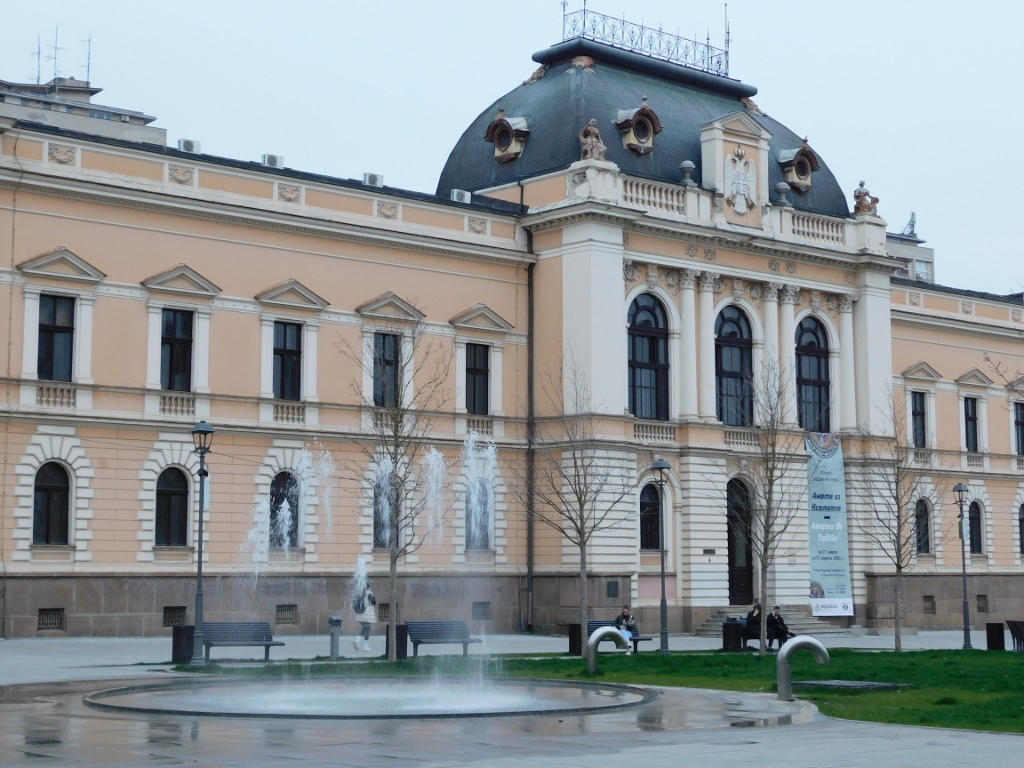 Palace of Culture in Kragujevac
Palace of Culture in Kragujevac
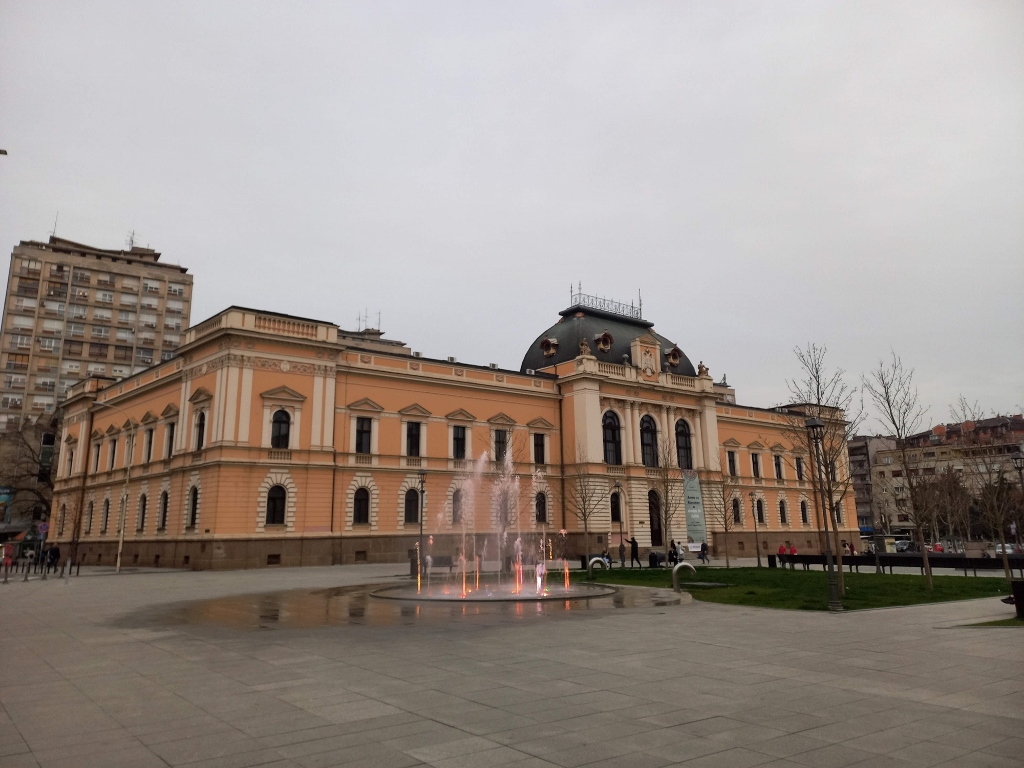 Palace of Culture in Kragujevac
Palace of Culture in Kragujevac
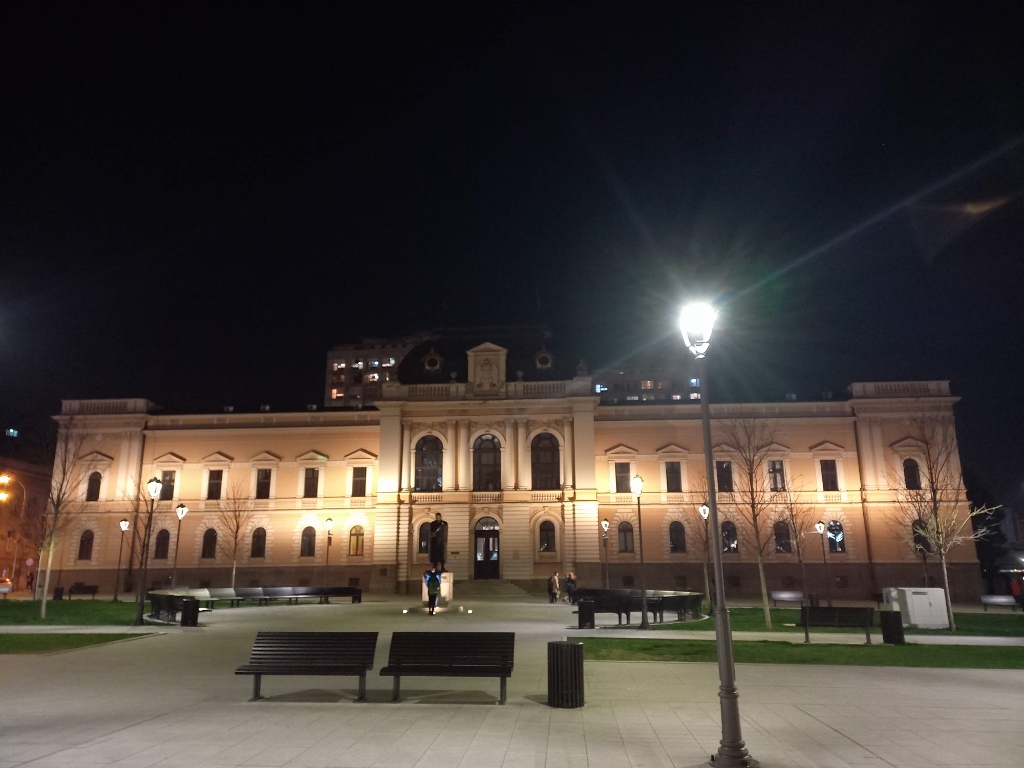 Palace of Culture in Kragujevac
Palace of Culture in Kragujevac
What interested me further about this building was its interior, specifically its appearance upon getting in through the main entrance. From what I had read, there is a monumental staircase with monolithic granite columns. I was wondering how I would even get in, as I didn’t know what was inside or if anything was operational. Once, I tried to enter in the morning, but the main doors were locked.
However, fortunate circumstances intervened.
Namely, one morning when I went to the building and tried to enter, I noticed a large panel and was delighted. For two reasons. The first was that there was an exhibition named “Amates de Xalitla” organized by the Embassy of Mexico in Serbia and the City of Kragujevac, and it was open in the afternoons on weekdays, quite suitably after my other obligations. This meant that I could enter the Palace of Culture, which I did. The young man at the reception desk emphasised that I could only visit the ground floor and the representative hall where the exhibition was located, and I was not allowed to go upstairs. I followed his instructions and only peeked into one of the side corridors.
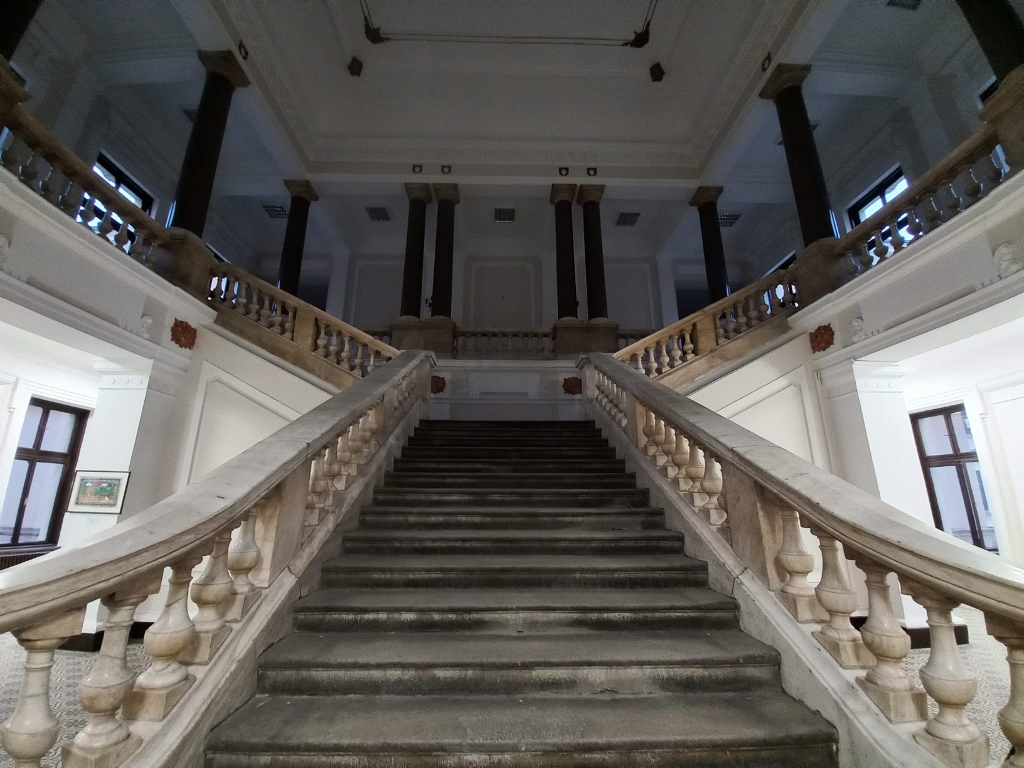 Palace of Culture in Kragujevac, a detail
Palace of Culture in Kragujevac, a detail
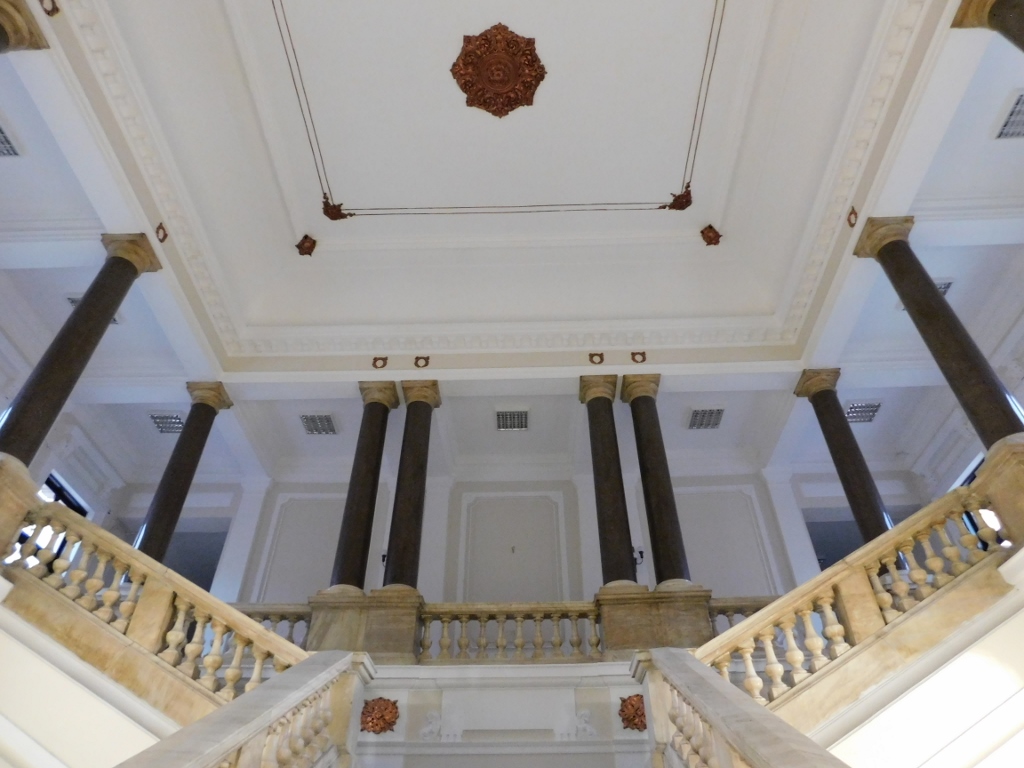 Palace of Culture in Kragujevac, a detail
Palace of Culture in Kragujevac, a detail
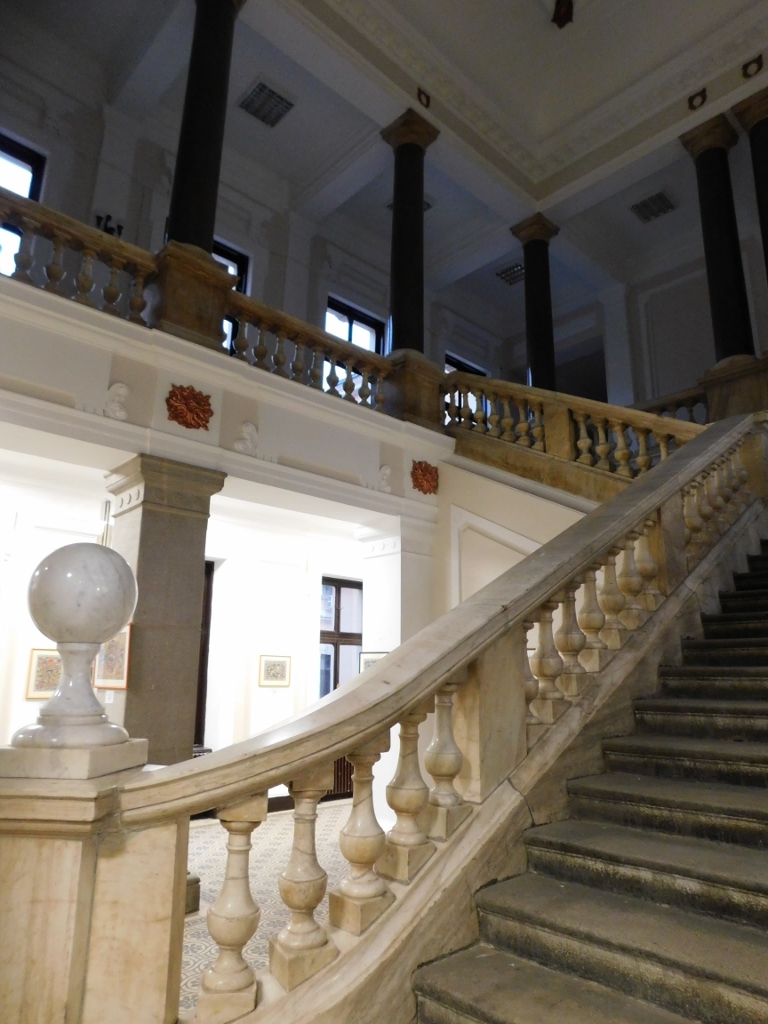 Palace of Culture in Kragujevac, a detail
Palace of Culture in Kragujevac, a detail
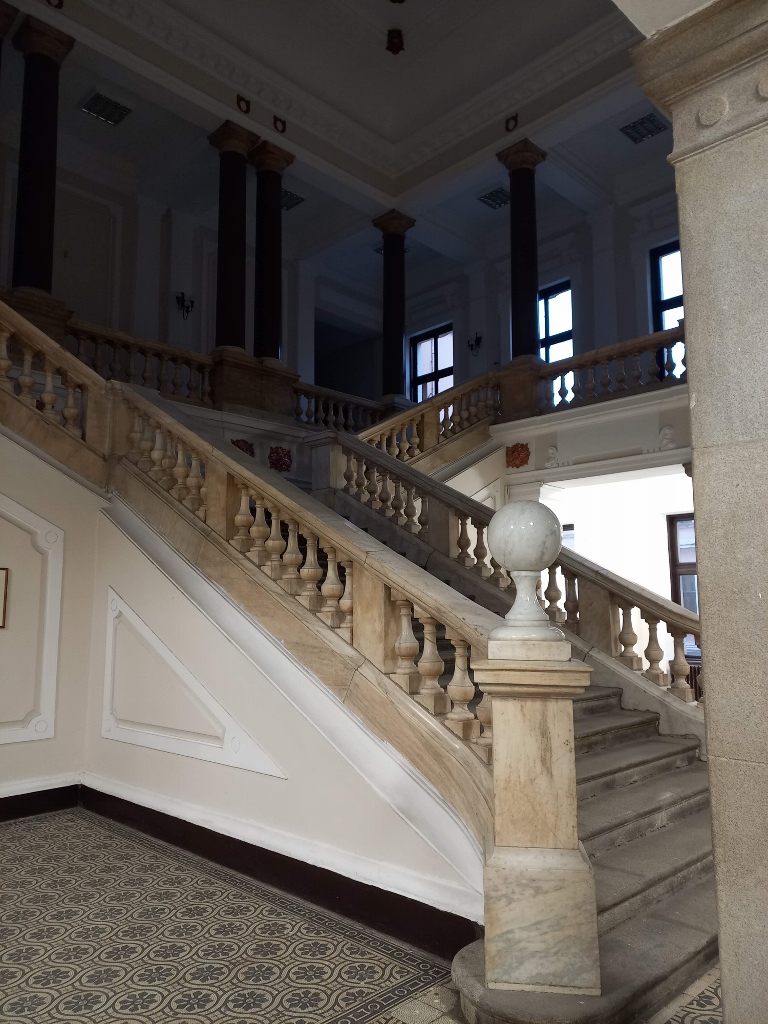 Palace of Culture in Kragujevac, a detail
Palace of Culture in Kragujevac, a detail
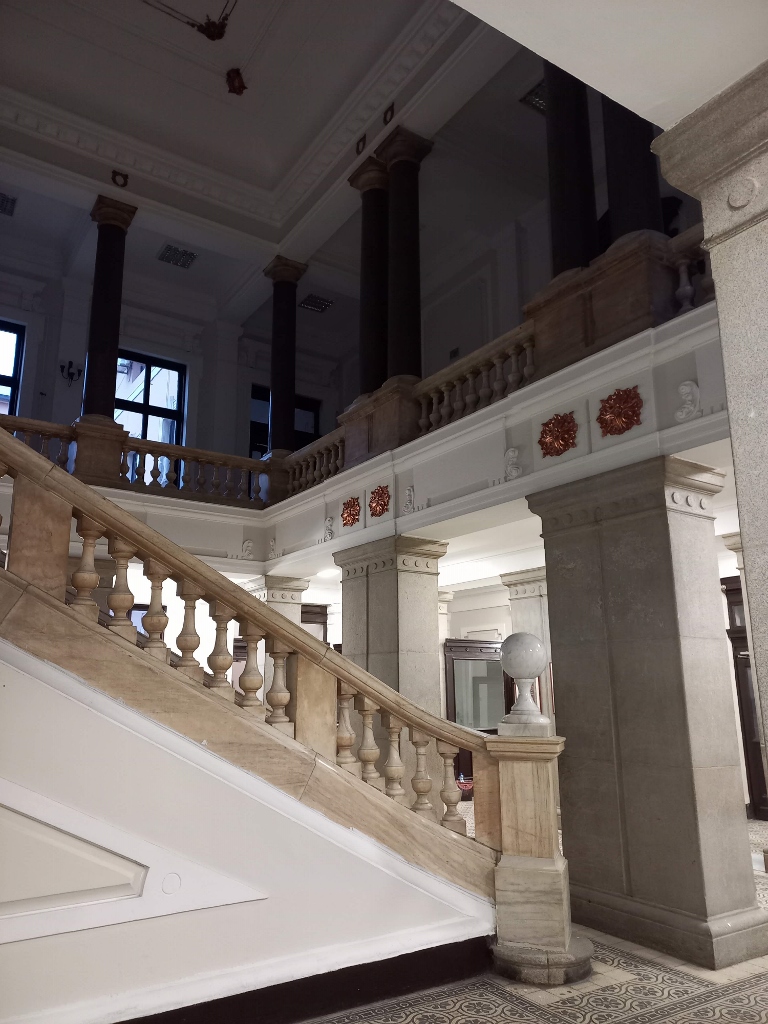 Palace of Culture in Kragujevac, a detail
Palace of Culture in Kragujevac, a detail
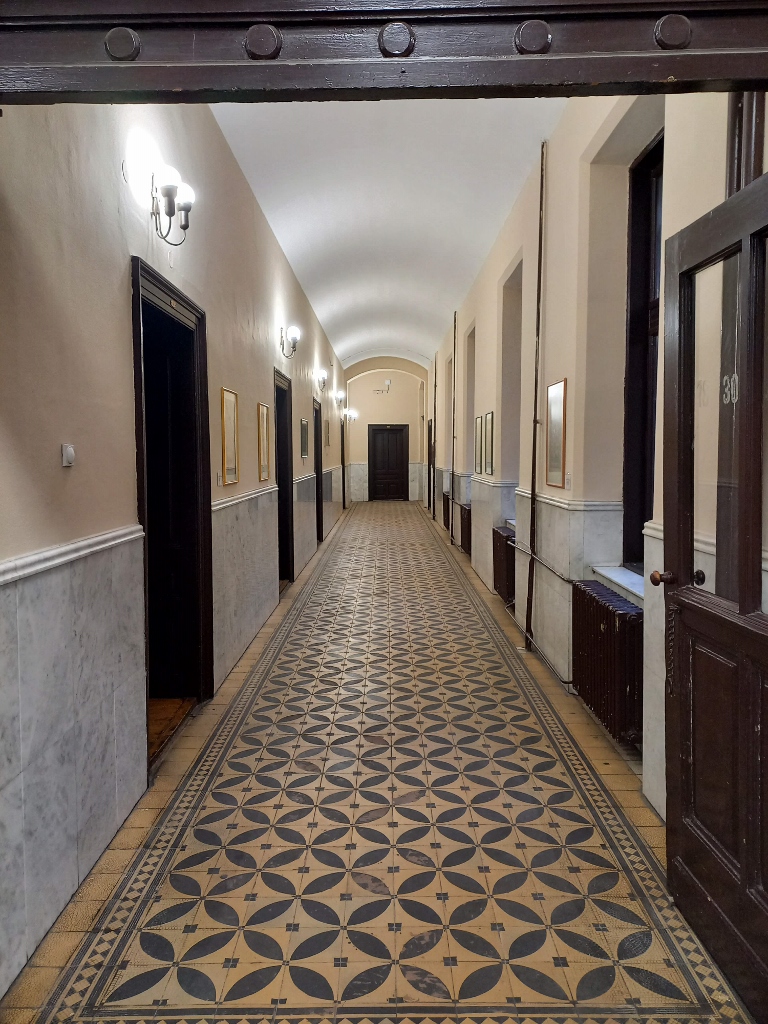 Palace of Culture in Kragujevac, a detail
Palace of Culture in Kragujevac, a detail
The second reason I was thrilled upon learning about this exhibition is that “amate” refers to bark paper produced in Mesoamerica long before the arrival of the conquistadors. It was used to record scientific and religious knowledge, historical events and administrative data. When the Spaniards arrived and conquered Central America, they banned the use of this paper as a means to destroy the written history and culture of the indigenous peoples. Over time, the tradition of amate nearly disappeared, although it continued to be crafted in some remote parts of the state of Puebla, primarily by folk artists from Guerrero. Now, the question arises: what fascinated me about all this?
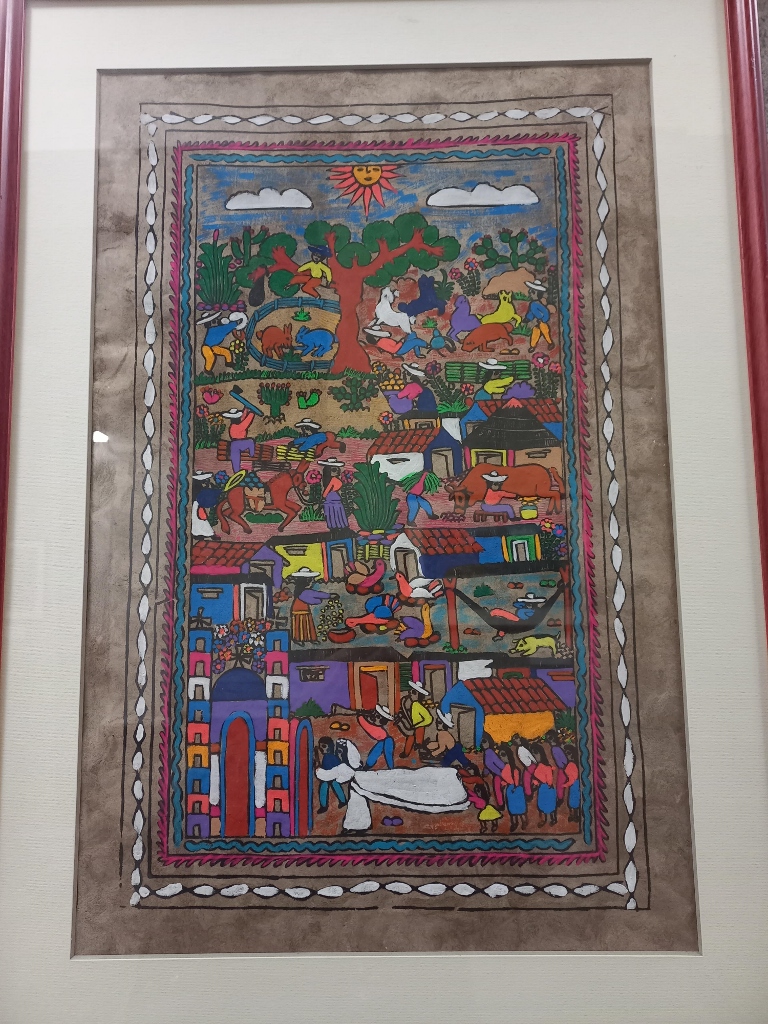 Painting on the amate paper at the exhibition at the Palace of Culture in Kragujevac
Painting on the amate paper at the exhibition at the Palace of Culture in Kragujevac
Well, long ago, I was in Mexico and passed through the state of Guerrero. Along the way, we stopped because, beside the road, there were some paintings for sale that resembled Mexican naive art. Without knowing what it was about, my friend Vesna and I bought a couple of pieces and one ended up framed in my flat. And now, finally, in Kragujevac, in March 2024 (almost 30 years after I had bought the amate paper painting), I found out what it actually was.
Oh, yes... I was delighted!
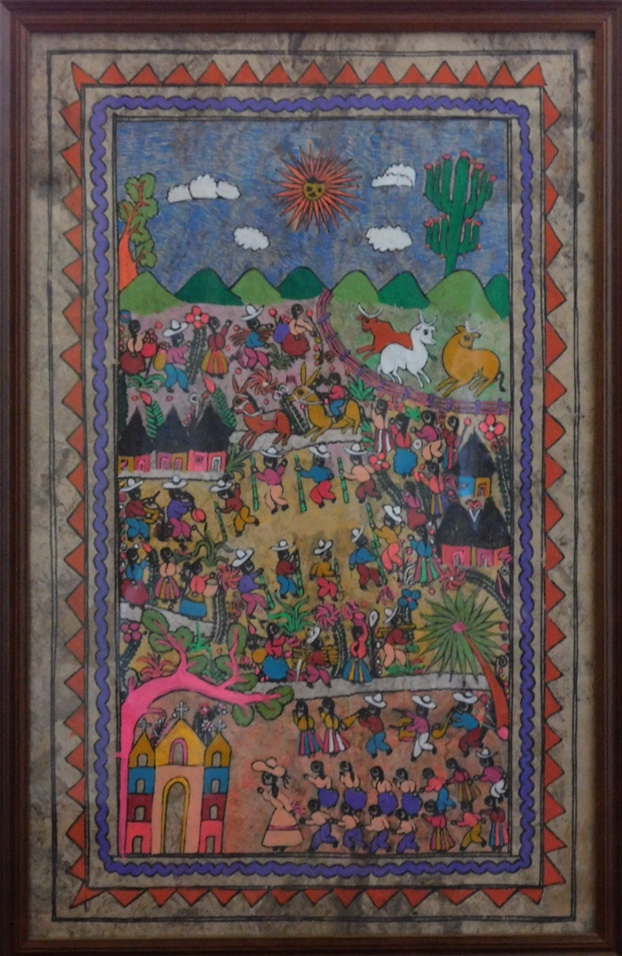 Painting on the amate paper in my flat
Painting on the amate paper in my flat